"Killing Fields" Lure Tourists in Cambodia
In the wake of the genocide in Cambodia during the 1970's, tourists are drawn to the killing fields of Phnom Penh.
The sight of 8,000 human skulls in a glass shrine stuns visitors into silence.
Outside, where cattle usually graze, human bones sometimes come unearthed after heavy rains.
In Cambodia, nine miles (14.5 kilometers) from Phnom Penh, the "killing fields" of Choeung Ek have become a tourist attraction, horrifying and fascinating. Choeung Ek is one of thousands of other such sites around the country where the Khmer Rouge practiced genocide during the late 1970s.
"There are two things you must see in Cambodia," says Scott Harrison, a traveler from Australia. "Obviously one is Angkor Wat. But the other is the killing fields outside Phnom Penh."
In the chronicle of 20th century horrors, Cambodia ranks high. For much of the last three decades, Cambodia has suffered through war, political upheaval and massive genocide.
Recently Cambodia has begun to revive. Its dark past is part of the reason: Tourist curiosity about Cambodia's genocide has become big business.
"Tourism has increased by 40 percent every year since 1998," says Chhieng Pich, economic counselor at the Cambodian embassy in Washington, D.C. "Nearly all tourists that visit Cambodia will go see Angkor Wat. Over 30 percent will visit the killing fields, too."
Few sights in one country can differ more markedly. Angkor Wat, the early 12th-century temple rediscovered in the 19th century (and designated a World Heritage Site in 1992 by UNESCO), reflects a profound spirituality.

1.7 Million Cambodians Dead
The killing fields document death. From 1975 to 1979, Pol Pot and his Khmer Rouge soldiers killed 1.7 million Cambodians, or 21 percent of the population, according to Yale University's Cambodia Genocide Program.
A soccer-field-sized area surrounded by farmland, the killing fields contain mass graves, slightly sunken, for perhaps 20,000 Cambodians, many of whom were tortured before being killed. The bordering trees held nooses for hangings.
A memorial building stands in the center of the killing fields. Many of the skulls inside were pulled from the mass graves.
Hundreds of Cambodians now make a living by guiding visitors through the killing fields and other genocide-related sites. Many guides tell harrowing personal stories of how they survived the Khmer Rouge, often by becoming refugees in Thailand.
Guides explain that bullets were too precious to use for executions. Axes, knives and bamboo sticks were far more common. As for children, their murderers simply battered them against trees.
The grisly memories translate into income. "Tourist dollars and capitalism are helping me come to terms with my country's history—and my own," says a Cambodian guide at the killing fields who didn't want to give his name. He lost his grandfather and uncle to the Khmer Rouge.
Tuol Sleng Museum of Genocide
"It's good tourists are coming here interested in Cambodia's past," says Stephen Bognar, a liaison officer for WildAid Cambodia, a nonprofit conservation organization. "They're boosting the country's economy and helping out the people."
Another notorious site is the Tuol Sleng Museum of Genocide in Phnom Penh. Once a high school, Tuol Sleng became a torture camp, prison and execution center.
Today the place looks benign, with palm trees and grass lawns in a suburban setting. From the outside, Tuol Sleng could be a school anywhere in the world. But inside are weapons of torture, skulls, blood stains and photographs of thousands of people who were murdered.
The scene just outside is also heartrending. Amputees of all ages beg near refreshment and souvenir stands where tourists congregate. The Khmer Rouge may be long gone, but many of the land mines they laid are still killing and maiming.
In a country where the annual per capita income is U.S. $260, begging can pay off.
"Beggars can easily make [U.S.] $3 to $4 dollars a day," says Lim Sehyo, a Phnom Penh taxi driver and guide. "If you work it out, that's over [U.S.] $1,000 a year."
As taxis full of tourists arrive at the killing fields, guides and beggars approach. Horror, memory, education and livelihood commingle at the site.
Related Topics
You may also like.
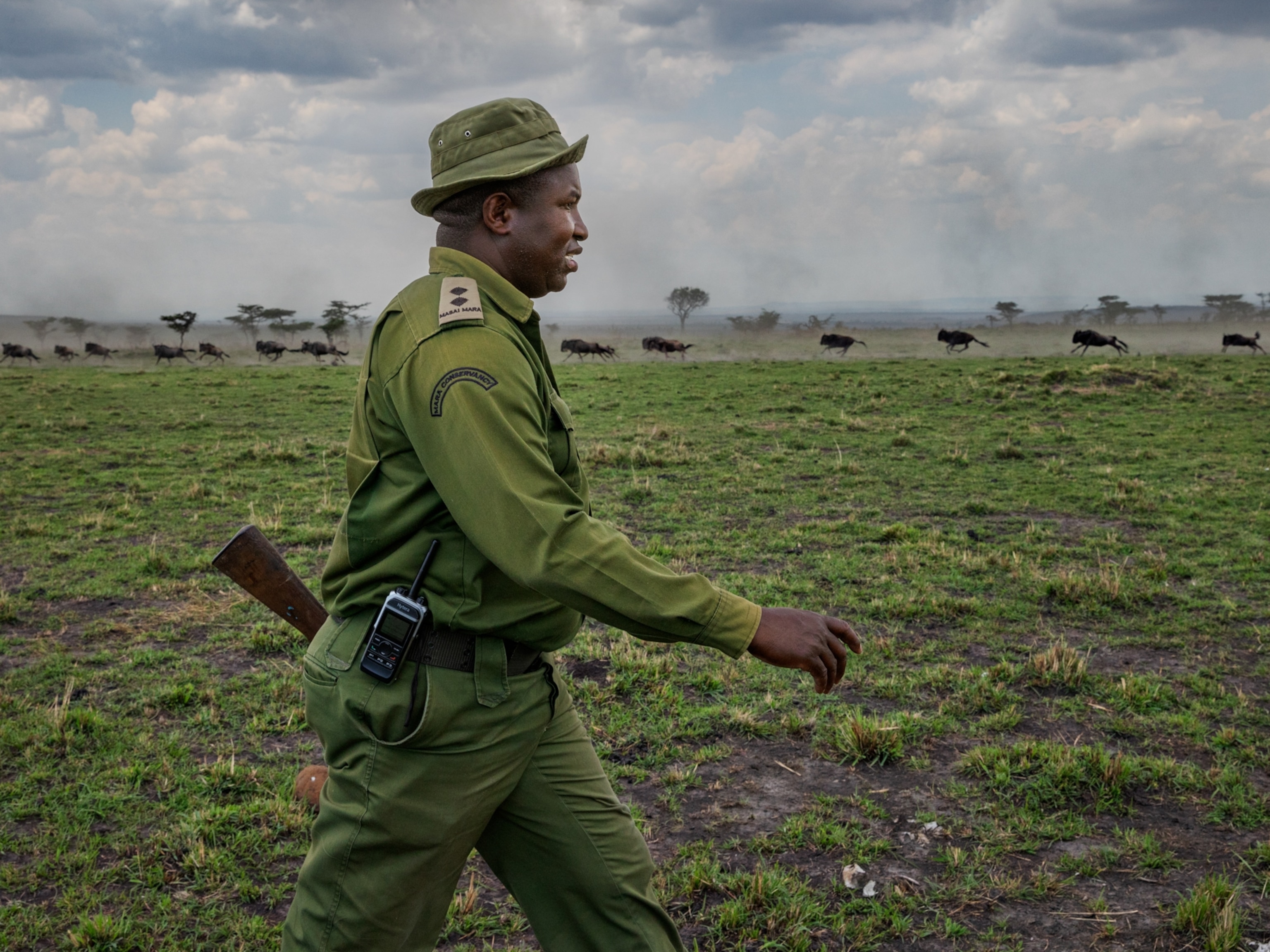
Beyond what tourists see, a rich Maasai culture with many challenges

How the Holocaust happened in plain sight

Rogue orcas are thriving on the high seas—and they’re eating big whales

Chile’s glaciers are dying. You can actually hear it.

‘Selfie’ flamingos in Caribbean resorts are being returned to the wild
- Environment
History & Culture
- History & Culture
- History Magazine
- Mind, Body, Wonder
- Coronavirus Coverage
- Paid Content
- Terms of Use
- Privacy Policy
- Your US State Privacy Rights
- Children's Online Privacy Policy
- Interest-Based Ads
- About Nielsen Measurement
- Do Not Sell or Share My Personal Information
- Nat Geo Home
- Attend a Live Event
- Book a Trip
- Inspire Your Kids
- Shop Nat Geo
- Visit the D.C. Museum
- Learn About Our Impact
- Support Our Mission
- Advertise With Us
- Customer Service
- Renew Subscription
- Manage Your Subscription
- Work at Nat Geo
- Sign Up for Our Newsletters
- Contribute to Protect the Planet
Copyright © 1996-2015 National Geographic Society Copyright © 2015-2024 National Geographic Partners, LLC. All rights reserved
Winter is here! Check out the winter wonderlands at these 5 amazing winter destinations in Montana
- Travel Destinations
How To Visit The Phnom Penh Killing Fields
Published: September 16, 2023
Modified: December 27, 2023
by Cory Foxworth
- Arts & Culture
- Plan Your Trip
- Travel Tips
Introduction
Welcome to the Phnom Penh Killing Fields, a somber and historically significant site located just outside the capital city of Cambodia. This haunting place serves as a reminder of the country’s dark past and has become an important destination for those seeking to understand the atrocities committed during the Khmer Rouge regime from 1975 to 1979.
The Phnom Penh Killing Fields, also known as the Choeung Ek Genocidal Center, is a memorial site that stands as a testimony to the brutalities and loss of life that occurred during this tragic period in Cambodian history. It has been preserved as a place of remembrance and serves as a stark reminder of the horrors of war and genocide.
Visiting the Phnom Penh Killing Fields is not just about witnessing the physical remains of the past; it is also an educational journey that allows visitors to gain insights into the resilience and strength of the Cambodian people. It provides an opportunity to learn about the historical context, the impact of the genocide, and the ongoing healing and reconciliation process that the nation has undergone.
This article will guide you on how to visit the Phnom Penh Killing Fields and make the most of your experience. From understanding the importance of this site to planning your visit, exploring the memorial grounds, and paying respect to the victims, we will provide you with all the essential information you need for a meaningful and respectful visit.
Before we delve into the details, it’s important to note that visiting the Phnom Penh Killing Fields can be a deeply emotional and unsettling experience. The site holds deep significance to many Cambodians who lost loved ones during the Khmer Rouge regime. It is essential to approach your visit with sensitivity, respect, and a desire to learn and understand. It is a chance to reflect on the devastating consequences of hate and violence while honoring the memory of those who perished.
Understanding the Phnom Penh Killing Fields
Before you embark on your visit to the Phnom Penh Killing Fields, it is crucial to have a basic understanding of the historical context and significance of this site. The Phnom Penh Killing Fields served as one of the many execution and burial grounds during the Khmer Rouge regime under the leadership of Pol Pot.
From 1975 to 1979, Cambodia experienced one of the darkest periods in its history. Under the ruthless rule of the Khmer Rouge, an estimated two million Cambodians lost their lives due to political purges, forced labor, and mass executions. The Phnom Penh Killing Fields, like other sites across the country, became the backdrop for unimaginable human suffering and tragedy.
The Choeung Ek Genocidal Center, commonly known as the Phnom Penh Killing Fields, was the final destination for thousands of prisoners who were transported from various detention centers throughout Cambodia. Despite the secrecy surrounding these atrocities, the Khmer Rouge regime couldn’t hide their crimes forever, and the mass graves at the Killing Fields became a testament to the horrors that occurred.
Today, the Phnom Penh Killing Fields stands as a symbol of remembrance and education, seeking to ensure that the atrocities committed during this period will never be forgotten. The site serves as a place of healing and reconciliation, allowing visitors to understand the impact of the Khmer Rouge regime on the Cambodian people and the ongoing process of rebuilding and moving forward.
At the Phnom Penh Killing Fields, you will have the opportunity to explore the grounds, visit the memorial stupa, and learn about the past through audio guides and guided tours. This experience will not only provide a somber reminder of the loss of life but also shed light on the resilience of the Cambodian people and their determination to create a better future.
It is important to approach your visit with empathy and an open mind. Remember that this is a site of immense historical importance and emotional significance for many Cambodians. Take the time to absorb the stories, reflect on the past, and honor the memory of those who suffered.
Now that we have a deeper understanding of the Phnom Penh Killing Fields, let us move on to planning your visit to this significant memorial site.
Planning Your Visit
When planning your visit to the Phnom Penh Killing Fields, there are some important factors to consider in order to make the most out of your experience and ensure a respectful visit. Here are some key points to keep in mind:
- Research and Learn: Before your visit, take the time to educate yourself about the history of the Khmer Rouge regime and the significance of the Phnom Penh Killing Fields. Understanding the context will enhance your appreciation of the site and the stories it holds.
- Timing: The Phnom Penh Killing Fields can get quite crowded, especially during peak hours. Consider visiting earlier in the morning or later in the afternoon to avoid larger crowds and have a more contemplative experience.
- Duration: Allocate sufficient time for your visit. Exploring the Choeung Ek Genocidal Center and its surrounding area can take a couple of hours. Give yourself ample time to reflect, read the information boards, and fully immerse yourself in the experience.
- Sun Protection: The Phnom Penh Killing Fields are mostly open-air, so be prepared for sun exposure. Wear sunscreen, a hat, and comfortable clothing to protect yourself from the sun’s rays.
- Comfortable Footwear: The memorial site encompasses a considerable area, including gravel paths and unpaved terrain. Wear comfortable shoes to navigate the grounds with ease.
- Transportation: Plan how you will get to the Phnom Penh Killing Fields. Tuk-tuks, taxis, or hired private transportation are all viable options. Discuss with your driver the desired length of stay and arrange a pick-up time for your return.
- Food and Water: Bring a bottle of water to stay hydrated during your visit. However, food consumption is not allowed within the grounds to maintain a respectful atmosphere.
- Sensitive Photography: While photography is permitted, exercise sensitivity when taking pictures. Some areas may be considered sacred, so ensure that you ask for permission before photographing individuals or specific sites.
By planning your visit ahead of time and considering these factors, you can ensure a respectful and meaningful experience at the Phnom Penh Killing Fields. Now, let’s explore how to reach this significant memorial site.
Getting to the Phnom Penh Killing Fields
Getting to the Phnom Penh Killing Fields from the city center is a straightforward process. It is located about 17 kilometers south of Phnom Penh, and there are a few transportation options to consider:
- Tuk-tuk: Tuk-tuks are a popular mode of transportation in Phnom Penh. Negotiate a fair price with the driver, and they will take you to the Killing Fields and wait for you during your visit. This gives you the flexibility to explore at your own pace.
- Taxi: Taking a taxi is another convenient option. Taxis are easily available throughout Phnom Penh, and most drivers will be familiar with the route to the Phnom Penh Killing Fields. Ensure that the driver uses the meter or agrees to a fair fixed fare before starting the journey.
- Private Transportation: If you prefer a more organized and comfortable experience, you can hire private transportation for your visit to the Killing Fields. Many tour companies offer transportation services, which include pick-up and drop-off from your hotel or a designated location.
Regardless of the transportation option you choose, it is advisable to discuss the duration of your visit and agree on a pick-up time with the driver. This will ensure a smooth and hassle-free return journey to Phnom Penh.
It is important to note that the Phnom Penh Killing Fields can be an emotionally charged place for many visitors. Taking public transportation or opting for a guided tour can provide you with additional information and insights from knowledgeable guides, enhancing your understanding of the site and its historical significance.
Now that you know how to get to the Phnom Penh Killing Fields, let’s move on to exploring what awaits you at the Choeung Ek Genocidal Center.
Exploring the Choeung Ek Genocidal Center
Once you arrive at the Phnom Penh Killing Fields, you will be greeted by the Choeung Ek Genocidal Center, the main memorial site within the grounds. Here, you will have the opportunity to learn about the atrocities committed during the Khmer Rouge regime and pay tribute to the victims.
As you start your exploration, it’s important to approach the site with respect and reverence. The Choeung Ek Genocidal Center consists of several important areas that offer distinct experiences:
- Memorial Stupa: The Memorial Stupa is a towering structure that houses the skulls and bones of thousands of victims recovered from the mass graves. It stands as a symbol of remembrance and serves as a stark reminder of the lives lost during the Khmer Rouge regime. Take a moment to pay your respects and reflect on the magnitude of the tragedy.
- Mass Graves: The Choeung Ek Genocidal Center features multiple mass graves where the victims were buried. Walking along the pathways, you will come across numbered signs that denote the different grave sites. Throughout the grounds, you will also find information boards that provide historical context and recount the stories of the victims. Take the time to read these accounts, allowing them to deepen your understanding of the site.
- Audio Guides: Audio guides are available at the Choeung Ek Genocidal Center. These guides provide detailed explanations, stories, and insights into the history of the site. Listening to the audio guide as you explore will enhance your understanding and provide a more immersive experience.
- Guided Tours: If you prefer a more informative and structured visit, consider joining a guided tour. Knowledgeable guides can provide in-depth explanations, answer your questions, and offer additional historical and cultural insights. Guided tours are available in various languages and can be arranged beforehand or upon arrival.
As you walk through the Choeung Ek Genocidal Center, it is natural to feel a mix of emotions. The stories of survival, loss, and resilience can be overwhelming. Take the time you need to process your thoughts and emotions, and remember to be respectful of fellow visitors who may also be experiencing their own profound reactions.
By exploring the Choeung Ek Genocidal Center, you will gain a deeper understanding of the tragedies that took place during the Khmer Rouge regime, fostering empathy and a commitment to ensuring that such atrocities are never repeated.
Next, let’s delve into the available resources that will further enhance your understanding and experience at the Phnom Penh Killing Fields.
Memorial Stupa and Mass Graves
At the heart of the Choeung Ek Genocidal Center lies the Memorial Stupa, a solemn and powerful structure that stands as a tribute to the victims of the Khmer Rouge regime. It serves as a poignant reminder of the atrocities committed during that dark period of Cambodian history.
The Memorial Stupa is a towering structure adorned with glass panels, inside of which are the skulls and bones of the victims recovered from the mass graves. As you approach the stupa, you will be overcome by a profound sense of collective loss, somberness, and remembrance.
Inside the Memorial Stupa, the remains of more than 8,000 victims are respectfully displayed. The skulls are carefully arranged by age and gender, providing a striking visual representation of the magnitude of the tragedy and the individual lives lost.
As you stand before the Memorial Stupa, take a moment to reflect on the lives that were unjustly taken. It is a humbling experience that reminds us of the importance of human dignity and the necessity of preserving the memory of those who perished.
Adjacent to the Memorial Stupa are the mass graves, where the victims of the Khmer Rouge were ruthlessly executed and buried. Walking along the designated pathways, you will come across numbered signs that indicate the grave sites.
These mass graves hold the stories of countless individuals who fell victim to the brutal regime. Each grave represents a chapter in the tragic history of Cambodia, a testament to the immense suffering and loss experienced during those dark years.
Throughout the Choeung Ek Genocidal Center, you will encounter informative signboards and displays that provide historical context and personal accounts of the atrocities that occurred. These provide a deeper understanding of the events that unfolded during the Khmer Rouge regime and stimulate contemplation about the importance of remembrance and justice.
Visiting the Memorial Stupa and mass graves is a profoundly moving experience. It serves as a reminder that behind the statistics and numbers, there were real individuals with families, dreams, and aspirations. By paying your respects, you contribute to the ongoing remembrance and preservation of their stories.
Now that we’ve explored the Memorial Stupa and mass graves, let’s uncover the available resources that can enhance your visit to the Phnom Penh Killing Fields.
Audio Guides and Guided Tours
When visiting the Phnom Penh Killing Fields, audio guides and guided tours can greatly enhance your understanding and appreciation of the site’s historical significance. These resources provide valuable insights, personal accounts, and contextual information that enrich your experience and create a deeper connection with the stories of the victims.
Audio guides are readily available at the Choeung Ek Genocidal Center. They offer self-guided tours and provide a wealth of information about each area you encounter during your visit. The audio guides walk you through the sites, detailing the history, significance, and personal stories associated with the Phnom Penh Killing Fields.
Using an audio guide allows you to explore at your own pace and tailor your experience to your interests. You can pause, rewind, and replay the audio content as you need, ensuring that you absorb the information to your satisfaction.
Additionally, guided tours are an excellent option for those seeking a more immersive and structured visit. Knowledgeable guides, often survivors of the Khmer Rouge regime or their descendants, lead you through the Choeung Ek Genocidal Center, sharing first-hand accounts and historical insights.
A guided tour provides an opportunity to ask questions, receive personalized explanations, and engage in meaningful discussions. The guides offer a deeper perspective into the significance of the site and its impact on the Cambodian people, fostering a greater connection to the stories of resilience and survival.
Guided tours are available in various languages, including English, Khmer, and French. They can be arranged in advance through tour operators or upon arrival at the Phnom Penh Killing Fields. Look for licensed tour guides who have a deep understanding of the site and can provide sensitive and accurate information.
Whether you opt for an audio guide or a guided tour, both resources serve to shed light on the historical, political, and social context surrounding the Khmer Rouge regime. They help you navigate the site and foster a deeper understanding of the complexities and impact of this tragic chapter in Cambodian history.
Be sure to allocate sufficient time for your audio-guided tour or guided tour, as they can add an extra layer of depth and insight to your visit. Ultimately, the choice between the two depends on your preferred style of exploration and the level of guidance and information you seek.
Now that we’ve explored the benefits of audio guides and guided tours, let’s discuss some important etiquette and reminders for your visit to the Phnom Penh Killing Fields.
Important Etiquette and Reminders
When visiting the Phnom Penh Killing Fields, it is crucial to be mindful of the solemnity and significance of the site. Here are some important etiquette and reminders to keep in mind:
- Show Respect: The Phnom Penh Killing Fields is a place of remembrance and honor. Approach your visit with a respectful attitude and considerate behavior. Speak softly, refrain from unnecessary noise, and be mindful of the emotions of others around you.
- Dress Appropriately: As a sign of respect, dress modestly when visiting the Phnom Penh Killing Fields. Wear clothing that covers your shoulders and knees, and avoid clothing with offensive or inappropriate imagery or messages.
- Photography Etiquette: While photography is allowed, it is essential to exercise sensitivity when taking pictures. Certain areas may be considered sacred, so always ask for permission before photographing individuals or specific sites. Avoid taking selfies or engaging in disrespectful behavior for photo opportunities.
- Silence Your Devices: To maintain a respectful and contemplative atmosphere, remember to silence your electronic devices. Keep your phone on silent mode and refrain from using it for non-essential purposes during your visit.
- Follow the Pathways: Stick to the designated paths and walkways throughout the memorial site. Avoid straying into restricted areas or disturbing the surrounding flora and fauna.
- Read and Listen: Take the time to read the informative signboards and listen to the audio guide or the insights of your tour guide. These resources provide valuable information and personal stories that further enrich your understanding of the Phnom Penh Killing Fields.
- Show Empathy and Sensitivity: The Khmer Rouge regime’s atrocities resulted in immense suffering and loss for the Cambodian people. Show empathy and sensitivity towards their experiences by listening attentively, learning from their stories, and seeking to understand the impact of the past on the present.
- Take Time for Reflection: The Phnom Penh Killing Fields can evoke intense emotions. Take the time you need to reflect, process your thoughts, and pay your respects to the victims. Engage in silent contemplation or find a quiet space to honor their memory.
By adhering to these important etiquette and reminders, you contribute to maintaining a respectful and considerate environment for all visitors. It is through our collective observance of these practices that we can honor the lives lost and create a meaningful experience at the Phnom Penh Killing Fields.
Now, let’s explore the possibilities for healing and paying respect at this significant memorial site.
Healing and Paying Respect
Visiting the Phnom Penh Killing Fields can be a deeply emotional experience. It is a place that evokes pain, sorrow, and a profound sense of loss. However, it is also a space for healing, reflection, and paying respects to the victims who suffered under the Khmer Rouge regime.
As you explore the Choeung Ek Genocidal Center, take the time to connect with the stories of the individuals whose lives were tragically cut short. Understand that each nameless grave represents a human being with their own dreams, aspirations, and loved ones left behind.
To pay your respects, you may choose to light incense at the memorial stupa or place flowers as a symbol of remembrance. These small gestures can have a powerful impact, allowing you to honor the memory of those who perished and acknowledge their suffering.
Engage in silent contemplation as you walk through the mass graves, acknowledging the pain and tragedy that occurred on this sacred ground. Take a moment to internalize the enormity of the atrocities committed and recognize the resilience of the Cambodian people in the face of such horror.
During your visit, you may encounter survivors of the Khmer Rouge regime or relatives of those who perished. Approach these encounters with compassion and respect, understanding that their presence at the Phnom Penh Killing Fields holds great personal significance.
Listening to their stories and engaging in meaningful conversations can provide a unique and personal perspective. Through these interactions, you can gain a deeper understanding of the profound impact the Khmer Rouge regime had on individuals and the nation as a whole.
Remember that healing is a personal journey, and each visitor will have their own way of processing the emotions that arise. Take the time you need to reflect, grieve, and find solace in the presence of the memorial site.
As you leave the Phnom Penh Killing Fields, carry with you the memories and lessons learned. Share your experience with others, raising awareness about the atrocities committed and the importance of promoting peace, justice, and respect for human rights.
Now that we’ve explored the healing and respectful aspects of visiting the Phnom Penh Killing Fields, let’s discuss how reflection and education play a vital role in our understanding of history.
Reflection and Education
Visiting the Phnom Penh Killing Fields offers a unique opportunity for personal reflection and education. It is a chance to confront the dark history of the Khmer Rouge regime and its impact on the Cambodian people. Through reflection and education, we can gain a deeper understanding of the past and strive for a better future.
As you walk through the Choeung Ek Genocidal Center, take the time to pause and reflect on the magnitude of the atrocities committed. Consider the stories of resilience, survival, and loss etched into the memorial site. Reflect on the consequences of hate, violence, and unchecked power, and ponder the importance of promoting peace, justice, and human rights in the world today.
Learning from the past is crucial to preventing the repetition of similar atrocities. Educate yourself about the Khmer Rouge regime, its ideology, and the circumstances that led to its rise to power. Seek to understand the complexities of the historical context and the struggles faced by the Cambodian people during this tumultuous period.
Engage with the available resources at the Phnom Penh Killing Fields, such as informative signboards and audio guides. Read personal accounts, listen to survivor stories, and absorb the historical information presented. These educational materials provide valuable insights into the Khmer Rouge regime and its repercussions, fostering a more comprehensive and informed understanding of this tragic chapter of Cambodian history.
Extend your learning beyond your visit to the memorial site. Further your understanding through books, documentaries, and conversations with survivors, scholars, and activists. Share your knowledge with others, raising awareness about the Khmer Rouge regime and its enduring impact. Education plays a critical role in preventing future atrocities and promoting empathy, understanding, and tolerance.
Use your reflection and education to advocate for justice and human rights. Support organizations and initiatives that work towards healing, reconciliation, and the prevention of genocide. Engage in conversations about the importance of preserving history, promoting peace, and creating a society where human rights are championed.
By reflecting on the past and educating ourselves about the Khmer Rouge regime, we can actively contribute to a world that values compassion, dialogue, and respect. The Phnom Penh Killing Fields serves as a powerful reminder of the consequences of hatred and tyranny, and it is our responsibility to ensure that these lessons are never forgotten.
Now, let’s conclude our exploration of the Phnom Penh Killing Fields and the invaluable experiences it offers.
Leaving the Phnom Penh Killing Fields
As you prepare to leave the Phnom Penh Killing Fields, take a moment to reflect on the profound impact of your visit and the emotions it has evoked. Leaving this memorial site requires a delicate balance of carrying the weight of the past while also seeking hope for the future.
Exiting the Choeung Ek Genocidal Center, it is important to respect the space and maintain the solemn atmosphere. Maintain a quiet demeanor and refrain from engaging in loud conversations or disruptive behavior.
Before departing, consider making a small contribution to support the preservation and maintenance of the Phnom Penh Killing Fields. Your donation can go towards the ongoing efforts to honor the victims, educate future generations, and ensure the site’s longevity as a meaningful memorial.
Take a moment to process and internalize the experience you have had at the Phnom Penh Killing Fields. Reflect on the stories you encountered, the emotions you felt, and the lessons you have learned. Carry these reflections with you as a reminder of the importance of understanding history and working towards a more just and peaceful world.
Know that the impact of your visit extends beyond the memorial site itself. Share your experience with others, whether through conversations or by utilizing social media platforms. By spreading awareness and educating others about the Khmer Rouge regime and the significance of the Phnom Penh Killing Fields, you contribute to the collective effort to prevent future atrocities and advocate for human rights.
Finally, as you leave the Phnom Penh Killing Fields, let the experience inspire you to engage in meaningful action. Support organizations and initiatives that promote healing, reconciliation, and justice. Explore opportunities to get involved in efforts to prevent genocide and support survivors.
Remember that leaving the Phnom Penh Killing Fields is not the end of your journey. It is the beginning of a continued commitment to learning, understanding, and fostering a world that respects and upholds human dignity.
Thank you for taking the time to explore the Phnom Penh Killing Fields. May your visit serve as a catalyst for empathy, education, and advocacy.
The Phnom Penh Killing Fields is a place of immense historical significance and remembrance. It serves as a solemn reminder of the atrocities committed during the Khmer Rouge regime and the profound impact it had on the Cambodian people. A visit to this memorial site is a journey of reflection, education, and paying respects.
Understanding the Phnom Penh Killing Fields requires empathy, sensitivity, and a willingness to learn. It is crucial to approach your visit with respect for the victims and their stories, recognizing the human lives that were lost and the perseverance of the survivors.
Planning your visit is essential to make the most of your experience. Research the history, allocate sufficient time, and consider the best mode of transportation to reach the memorial site. Dress appropriately and be mindful of the solemnity of the surroundings.
Exploring the Choeung Ek Genocidal Center allows you to witness the Memorial Stupa and the mass graves. Engage with the provided resources, such as audio guides or guided tours, to deepen your understanding of the site and the events that unfolded there.
During your visit, adhere to important etiquette, such as showing respect, dressing modestly, and being mindful of photography etiquette. Take the time to reflect, honor the memory of the victims, and engage in moments of personal healing and contemplation.
Embrace the opportunity for education and reflection, both during your visit and beyond. Learn about the historical context, listen to survivor stories, and expand your knowledge to promote peace, justice, and human rights.
As you leave the Phnom Penh Killing Fields, carry the impact of your visit with you. Share your experience, support initiatives that promote healing and accountability, and advocate for the prevention of genocide.
Remember that the Phnom Penh Killing Fields is more than a place. It is a testament to the resilience and strength of the Cambodian people and a symbol of the ongoing journey towards healing and reconciliation.
By honoring the past, understanding its impacts, and working towards a more compassionate and just future, we pay tribute to the victims and ensure that the lessons of history are never forgotten.

- Privacy Overview
- Strictly Necessary Cookies
This website uses cookies so that we can provide you with the best user experience possible. Cookie information is stored in your browser and performs functions such as recognising you when you return to our website and helping our team to understand which sections of the website you find most interesting and useful.
Strictly Necessary Cookie should be enabled at all times so that we can save your preferences for cookie settings.
If you disable this cookie, we will not be able to save your preferences. This means that every time you visit this website you will need to enable or disable cookies again.
- Visit Oyster on Facebook!
- Visit Oyster on Pinterest!
- Visit Oyster on Instagram!
- Visit Oyster on Twitter!
- Subscribe to stay up to date!
Yes, send me expert tips and deals!
By proceeding, you agree to our Privacy Policy and Terms of Use .
- Subtract one room 1 Rooms Add one room
- Subtract one adult 2 Adults Add one adult
Visiting Cambodia's Killing Fields, a Dark Tourism Travelogue
See recent posts by Kyle Valenta
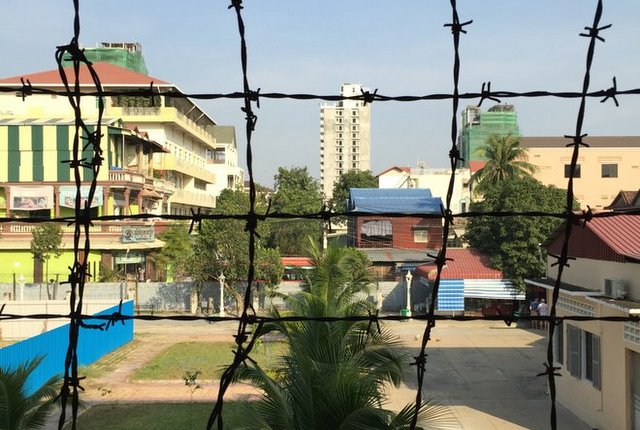
This guy calls himself "G" and that stands for garnet, but we see none of those blood-red stones anywhere on his body. Instead, there are long stretches of tanned white skin over sharp bones, a silk shirt billowing open in the breeze. It’s hot and we’re a little woozy, but this is Phnom Penh and that’s the Mekong River and I’m feeling more alive than I have in days. G says we must try the local coffee and wants to know where we were on 9/11. We’re walking to some sad little cultural show at the National Museum and we just can’t shake him.
“But you shouldn’t do that, you know?” he says, though it’s not clear he means it. He must sense our confusion. “You shouldn’t visit those places,” he mumbles. “At least not in the same day.”
He’s talking about the Killing Fields at Choeung Ek and the Tuol Sleng Genocide Museum. They are major tourist sites in Phnom Penh, and commemorate the atrocities perpetrated by Pol Pot and the Khmer Rouge on Cambodia in the 1970s. During that time, millions of Cambodians around the country were forced to evacuate Phnom Penh and other cities for communal labor camps where murder, starvation, and torture killed at least two million people.
But we are here to visit both places. For a day, we are going to be genocide tourists.
What Is Dark Tourism?
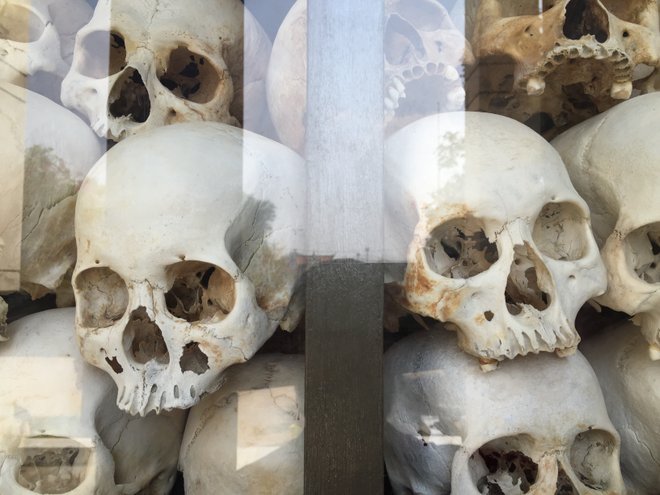
Sites of tragedy draw millions of tourists around the world every year. According to the Times of Israel , Auschwitz saw 1.7 million guests in 2015, breaking its own record. In the United States , the 9/11 Memorial & Museum has been visited by more than 28 million people since opening in 2011. Our psyches are riveted to these places, creating a complex network of commerce, memory, and healing. Tourists, after all, have needs and wants; so do those who bore witness to the tragedies being memorialized.
When I spoke with Dr. John Lennon — who helped coin the term “dark tourism” (the phenomenon of visiting sites of tragedy) and has done extensive research on the power of these places — he suggested that competing motivations may be at work. “These sites provide a narrative and a voice for victims and shed light on our abilities as humans to perpetrate evil,” he said. “The fascination we have with the darker side of our nature and its consequences is not unique to them.”
The easy explanation as to why these places remain popular is that we visit them to safeguard against future tragedies. By forcing remembrance, we enact a prohibition. However, as Dr. Lennon acknowledges, this fails to recognize that all humans carry within them the propensity toward cruelty. In other words: The line between civility and atrocity is always razor thin.
As we made our way to the Killing Fields that late January morning, it was impossible not to feel a little weight, a little uneasiness about it all.
Sacred and Profane Things: Visiting the Fields
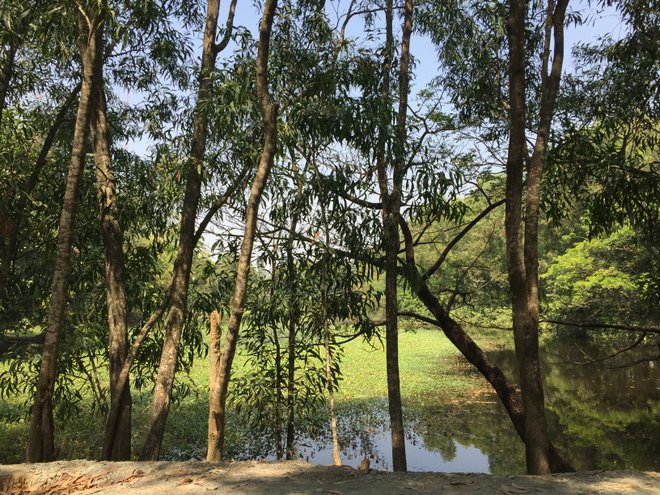
Phnom Penh spills away in the way that all South and Southeast Asian cities seem to suddenly dissipate: The concrete and brick buildings become shacks, then become small towns staggered along dirt roads. On the road to Choeung Ek, though, the massage parlors (which are really brothels) are conspicuous between all of the other commerce. At certain breaks between the roadside stalls, brilliant glimpses of green, the rice fields, glimmer. The idyll is right next to the reality; it all emerges at the same time.
We hold onto the bars in the tuk-tuk as we’re bounced from side to side over rutted roads until we eventually arrive. I notice that David and I aren’t talking all that much, and despite knowing that G was just some spun North American who went too far down the backpacker hole, I can’t shake his warning to us. As we walk to buy our tickets, though, the Killing Fields look like a slightly unkempt Buddhist garden. I breathe a little easier. There are wide swaths of patchy grass, flowering shrubs, butterflies sipping nectar, and a gleaming white stupa towering over it all. One can’t help but slide into cliches: It looks so peaceful; there’s so much beauty; how could this be it?
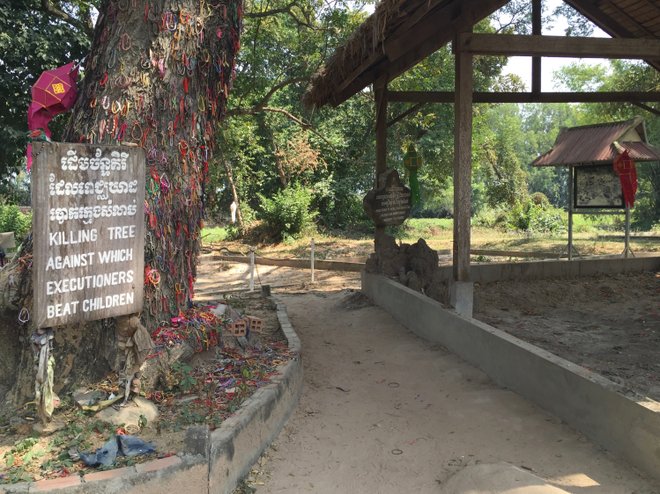
When sites of tragedy become tourist destinations, there’s slippage between reverence and entertainment. Popular games plant characters at former concentration camps , teenagers snap goofy photos of themselves, base jumpers attempt dives from the recently completed World Trade Center. This isn’t surprising to Dr. Lennon, who reminded me that, “Film, TV, books, games are littered with examples [of tragedy] — we remain interested in death, disaster, mass killing, and the least flattering elements of what it means to be human.” When a vacation is added to the mix, it’s even more difficult to extract the visit from the context of pleasure and detachment. This “getaway” time is, after all, not supposed to be real life.
Kate Monaghan, Communications Director at the National September 11 Memorial & Museum, explained that education and respect have been the core mission at the memorial since day one. “From the earliest stages of planning in 2006, it was understood that the 9/11 Memorial & Museum would be a place of learning, remembrance, and inspiration,” she said. “It’s set up to engage the visitor directly by both beginning and ending with personal reflections from a variety of experiences.” From those reflections from others, come the visitor’s own — but no two people have the same idea of reflection, remembrance, and mourning.
As I use my t-shirt to blot tears from my eyes at Choeung Ek, I look around at other visitors. Our audio guides pump the words of Ros Kosal and other survivors of the Khmer Rouge directly into our ears. Tourists kick at the dirt paths. Others look downward or upward. A few are choked up, but I’m shocked at the number that’s seemingly holding it completely together. How can that be? There’s that tree, where soldiers bashed the heads of infants; or that other tree, where they hung speakers blaring communist propaganda to muffle the screams of those being slaughtered. It’s a never-ending wave of horror, all of it just 40 years old, the earth still giving up fragments of bone and cloth from the mass graves underneath.
Are they grieving? Am I allowed this grief for a place that isn’t mine?
It’s impossible to say out loud which is right or wrong, but one suspects the answer is supposed to be clear.
It Was a Day Like Any Other
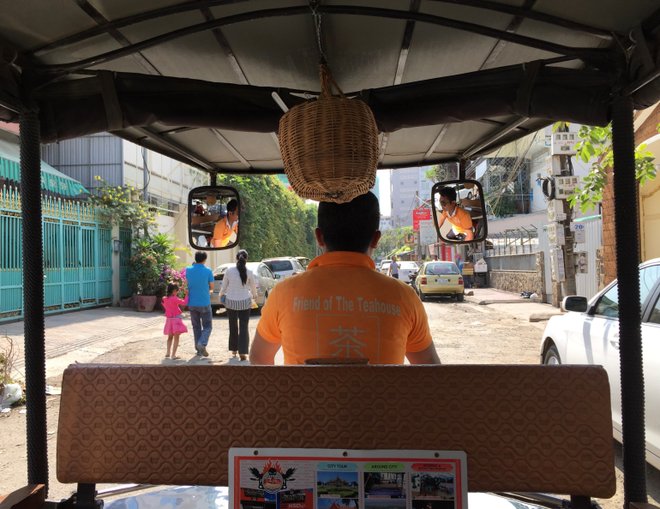
But we are tourists, and so one does as tourists do.
Here we are sitting in this ramshackle cafe sipping thick and sweet Khmer coffee. Here we are snapping pictures of each other. Here we are talking about when we might eat our next meal — What’re you thinking for dinner tonight? Street noodles again or something with air-conditioning?
Just at the corner, though, is Tuol Sleng — the whitewashed school-turned-prison where thousands were interred, tortured, shipped to labor camps, and murdered. It is now a museum, the former classrooms packed with original three-foot-wide brick cells, iron bed frames, razor wire, and row after row of black-and-white photos of Cambodians — some children, some women, some men, heads held in place by an occasionally visible metal brace.
Outside, the street bustles with tuk-tuks, vendors pushing carts, mothers holding children’s hands. White apartment blocks line both sides of the road, and from the outside Tuol Sleng looks just like any other white building. Sometimes these places just slip into the fabric of daily life, without fanfare. That’s how it starts, though, right? Everything just seems so normal, and then suddenly: It was a beautiful September day, not a cloud in the sky. Every American of a certain age knows what image comes next.
Never Forgetting, or Forgetting to Remember
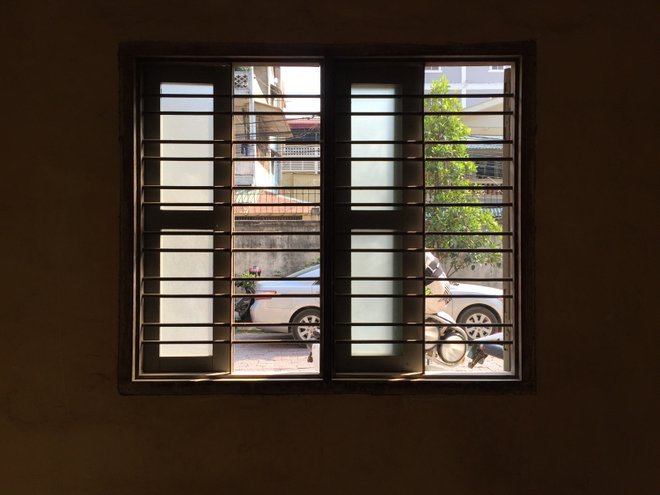
While the dark and the light may both be in our nature, it’s also instinctual to preserve and remember. That much seems borne out by history in the form of cemeteries, war memorials, triumphal arches, and parks erected on sites of fallen buildings. When this happens, they become part of the fabric of our everyday landscape. A quick search for images of the Oklahoma City National Memorial — the former site of the Alfred P. Murrah Federal Building — turns up an image of a toddler dipping a toe into the reflecting pool. Or there’s the marathon in its honor, thousands of screaming spectators cheering on the runners. In this sense, maybe, the place of horror becomes less devastating by way of normalization. It’s power to harm is diminished and it becomes a conduit to healing, or a scar that’s blended into the larger body once again. However, there are risks with this normalizing.
Along the streets around the 9/11 Memorial, vendors sling t-shirts imploring buyers to “Never Forget.” An admirable enough notion, but the gesture can turn the memorial into some cheap souvenir. At Choeung Ek, I saw no junk peddlers, but there are more insidious dimensions to the tourist trade in Cambodia. After all, the way to the Killing Fields is lined with those massage parlors where body work comes cheap and young.
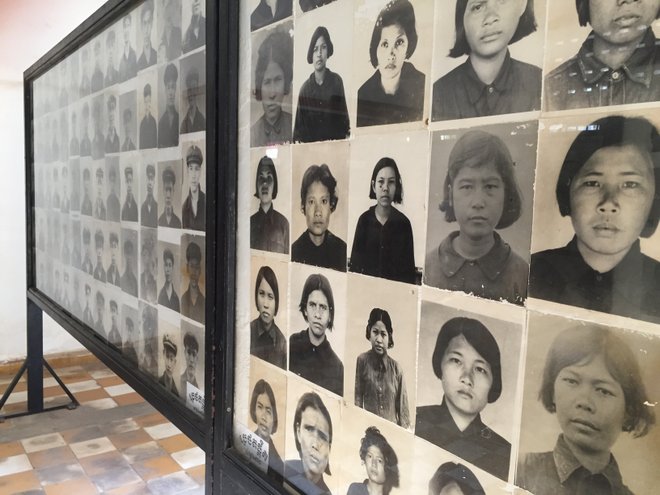
We never saw G again during our time in Phnom Penh, but I don’t know if he was right. It seems that encouraging the visiting Tuol Sleng and the Killing Fields on separate days is just another way to make atrocities more palatable for a traveler. That is, after all, what the commenters in various Cambodia travel forums have in mind when they recommend against visiting both sites in one day. “It’s too much,” they say, as though a convenient dosage of sadness and reality exists that will enlighten, but not interrupt, the vacation undertaken. In that way, sites like these become just another museum, just another check mark on the bucket list.
It’s not mine to say what visitors should or should not do at places like Choeung Ek. Nor at the 9/11 Memorial. Nor Auschwitz. But there was a minute — no, not a minute, but a stretch of a few days — where I was certain I could remain committed to kindness, to openness, to understanding, to feeling less antagonistic by everyone else in the world.
It was a fleeting sensation, and then it was gone. That alone, though, might be the point.
Related Links:
- We Love New York: Scenes of a Resilient City
- What It’s Actually Like Landing In India for the First Time
- 12 Morbid Museums Around the World
All products are independently selected by our writers and editors. If you buy something through our links, Oyster may earn an affiliate commission.
Top Stories

- Travel Tips
Top 11 Las Vegas Hotels on the Strip for Every Type of Traveler
By Christina Vercelletto

The 16 Most Stunning Coastal Destinations in Europe
By Lara Grant

- Captiva Island
The 10 Cutest Beach Towns in Florida
By Neil Gladstone

- Dominican Republic
Hotel Face-Off: Excellence Punta Cana vs. Excellence El Carmen
By Megan Wood

12 Things to Ask for When You Check Into Your Hotel Room
By Toby Orton

The importance of visiting Cambodia’s Killing Fields
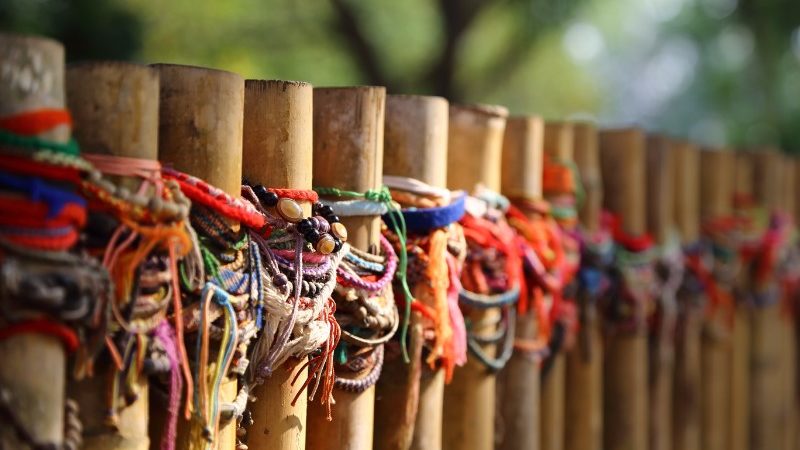
Visit Phnom Penh today and, at first glance, the scars of genocide are far from visible. Cambodia’s capital is the country’s most populous city – busy, vibrant, cultured.
Yet just decades ago it was a ghost town. Those living in urban areas were forced to work in rice fields. Teachers, doctors, those knowing a foreign language, or even simply wearing glasses were exterminated. As Keasar Hong, Intrepid’s Senior Tour Leader in Cambodia put it, the country held host to “the most anti-intellectual movement of all time”.
Yes, it’s fair to say that Cambodia in the late 1970s was a very different place. And on the list of 20th century horrors, the Southeast Asian nation ranks high.
But let’s backtrack in the name of context. What happened? The Khmer Rouge took control of the Cambodian government in 1975, aiming to transform the country into a communist agrarian utopia. Until liberation four years later, anyone perceived as educated, wealthy or opposed to the government’s aims was tortured and killed. That, or subject to slave labor in rural camps – the remnants of which form Cambodia’s “Killing Fields”, sites visitable to this day.
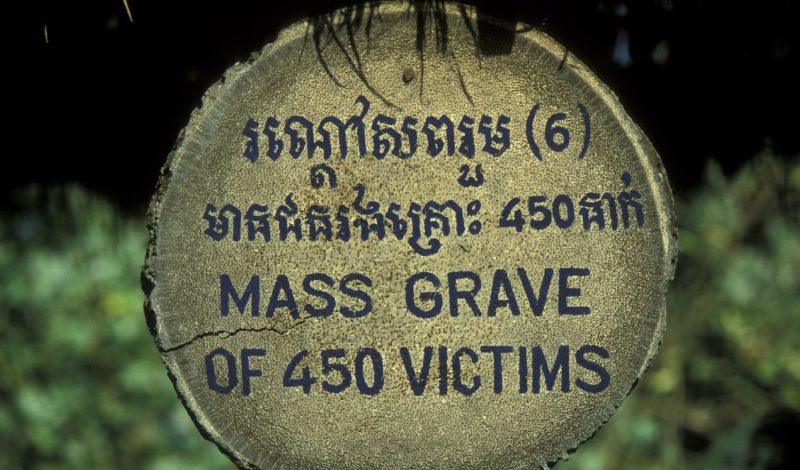
Killing Fields of Choeung Ek
All in all, over one million Cambodians lost their lives. For such a small country this equates to almost one in five dying as a result of the regime, whether from disease or starvation. And the impact is more devastating than visitors can comprehend. Even aside from the destruction of physical infrastructure and loss of human resources, the genocidal aftermath created a psychological legacy that has crippled the development of Cambodia.
FOR MORE LOCAL INSIGHT, CHECK OUT THIS INTERVIEW WITH A CAMBODIAN TOUR LEADER
The good news is that, as a traveler to Cambodia, you can help. Intrepid’s Cambodian tour leader Hong views visits to Tuol Sleng Prison Museum and Choeung Ek as an essential component of understanding Cambodia and its people. (The former is a former school that served as a Khmer Rouge base, the largest center of detention and torture in the country; the latter a memorial to the torture victims, the site of the Killing Fields, and home to a structure of over 8,000 human skulls.)
Visiting either, or both, is vital to getting to grips with the nation’s history and current state of development.
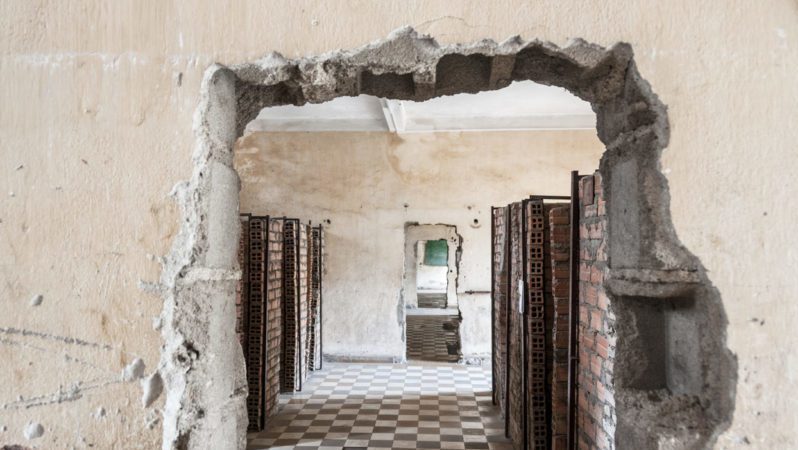
Tuol Sleng Prison Museum
And since virtually every family in Cambodia has been affected by the genocide and its aftermath, visiting the sites respectfully is as important as you’d expect. Hong advises dressing modestly (wearing shirts that cover shoulders, and pants or skirts that cover knees) and being quiet and somber, out of awareness of the surroundings. Clearly, prancing around skulls and posing for photos doesn’t show an understanding of the gravity of the site. Neither does ignoring signs that quite bluntly say “please don’t walk through the mass grave”.
But visiting the Killing Fields just to understand Cambodia’s past is only part of the story. Visiting them is also important in highlighting how multidimensional the country is. Because when you usually hear ‘Cambodia’, what do you think of? Angkor Wat, in all likelihood.
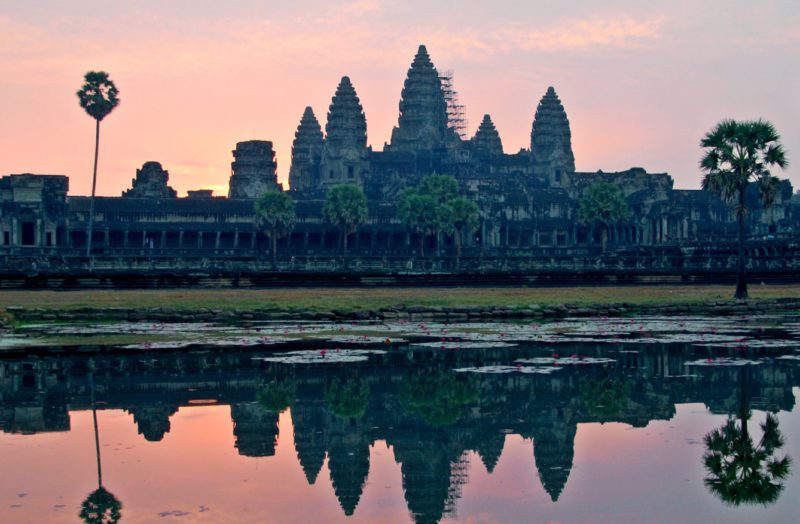
SUBSCRIBE TO OUR NEWSLETTER FOR TRAVEL INSPO, GIVEAWAYS & MORE
But if you can’t get genocide out of your mind, you’re probably wondering how you can help the country recover from its tragic past and develop its much-needed tourism industry. In addition to respecting the country’s culture, religion and traditions, it’s all about buying local. Hong encourages visitors to eat local, shop local and do anything they can to support the incomes of Cambodian families.
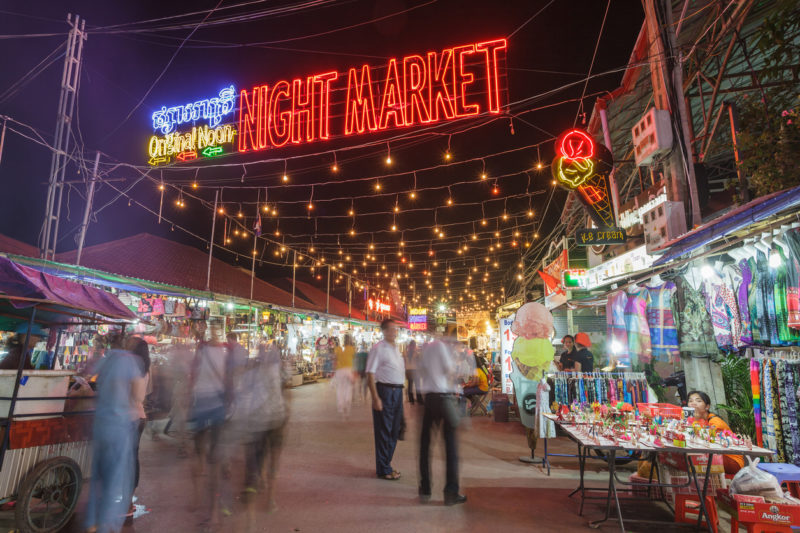
Night market in Siem Reap
There are admirable projects throughout the country that help with this, and of these, three stand out. In Sihanoukville you can visit The Starfish Project – a cafe run by the Intrepid Foundation, offering delicious baked goods and, more importantly, support for locals with disabilities. In Siem Reap you can enjoy Phare – an incredibly lively, nightly circus that helps disadvantaged Cambodian youths. And in Kampot you can experience a traditional massage by a blind masseur or masseuse, thanks to a center that allows blind Cambodians to support themselves with dignity.
All worthy causes and worthy projects, but it must be remembered that many of them are necessary, in part, because of the genocide and its aftermath. And, as has become clear, the only way to really understand its horrors and these impacts is by visiting the Killing Fields. Respectfully, of course.
Inspired to visit Cambodia yet? Intrepid’s 14-day Best of Cambodia tour covers the harrowing history, aforementioned social enterprises, and all the awe-inspiring beauty and culture you could want.
Image credits (top to bottom): Shutterstock, iStock (x2), Intrepid Travel (x2)
Feeling inspired?
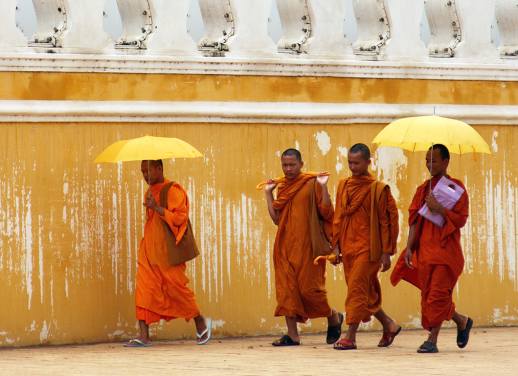
Bex Shapiro
Born in London and based in Toronto, Bex is happiest anywhere she can connect with interesting people over good food. She's passionate about sustainable travel and powerful storytelling, and her favourite cities are New York and Shanghai. She's also the Senior Editorial Manager at Intrepid. Follow her adventures on Twitter and Insta @BexShapiro.
You might also like
The 7 best places to go on a..., galapagos or madagascar which unique destination should be..., travelling to chile here’s the best time to..., 10 reasons to visit samoa, the 10 antarctica questions you want answered, australia or new zealand where to go on..., 10 epic spots to stop at on your..., small group travel vs coach tours: which is..., costa rica or mexico: which country to check..., 7 of the best destinations for solo travellers..., machu picchu or chichen itza which historical site....
- A Guide To Cambodias Killing...
The History of Cambodia's Killing Fields

During the Khmer Rouge reign, from 1975 to 1979, an estimated 1.7m to 2.5m Cambodians died from execution, starvation or disease – almost a quarter of the population. Killing fields dot the country, with more than 20,000 mass grave sites containing more than 1.38m bodies, according to the Documentation Centre of Cambodia. The largest of the killing fields was Choeung Ek, which sits on the outskirts of Phnom Penh and today serves as a monument to all those who died – and those who survived. It is also an educational tool that could help us to ensure that history of Cambodia never repeats itself.
Did you know you can now travel with Culture Trip? Book now and join one of our premium small-group tours to discover the world like never before.

Angkor Wat, Siem Reap, Cambodia One of the darkest times in modern history was in Cambodia between 1975 and 1979, when the Pol Pot-led Khmer Rouge ruled the country. They promised peace after years of civil war and secret bombing campaigns from the United States; Cambodians flocked the streets to welcome soldiers during the fall of Phnom Penh on 17 April 1975.
Tuol Sleng – S-21 – was the main political prison, and was where suspected enemies of Angkar were sent. As Pol Pot and the top commanders’ paranoia spiraled, so did the number of Cambodians detained here. Once inside, prisoners were either tortured to death or sent to nearby Choeung Ek for re-education – meaning execution. An estimated 12,273 were detained at S-21, with only seven known survivors.
Those sent to Choeung Ek made the 17km (11mi) journey crammed into the back of trucks. Once there, many were blindfolded and, not wanting to waste bullets, soldiers smashed spades into their heads before pushing them into pits containing the dead bodies of thousands. It is thought that about 17,000 men, women and children were executed at the site.
In 1980, the remains of almost 9,000 people were exhumed from the mass graves that litter the former orchard. Many of these skulls now sit in a memorial stupa that was created in 1988 and forms the centerpiece of the site, serving as a reminder of the bitter past and helping to ensure the lives lost are never forgotten.

Today, it’s hard to imagine a former longan orchard is a place that harbours such horror. Birdsong rises from the trees, the gentle breeze wafts through manicured fields, flowers bloom, shimmering paddies surround the site and life goes on.
However, this isn’t any orchard in Cambodia; it was the main Khmer Rouge killing field, and horrific reminders can be found at every step – a visit to Choeung Ek is a sobering one. Of the 129 communal graves, 43 have been left untouched. The many bone fragments, teeth and scraps of bloodied cloth retrieved sit in glass containers for visitors to see.
An audio tour guides visitors around the site, with compelling stories from survivors, guards and executioners. A visit to the Killing Fields is harrowing, emotional, and draining, but it offers a compelling insight into a fraction of the atrocities that took place across the country under the genocidal regime.
Remembrance
Choeung Ek was transformed into a memorial site and tourist attraction in a bid to educate Cambodians – and the world – about what happened, while also commemorating those who died. A memorial ceremony is held on 9 May each year, at which Khmer Rouge survivors and their relatives, officials, students from across Phnom Penh and other Cambodians gather at the stupa to remember the dead.
1. The Killing Fields as a tourist site
Historical Landmark

While there is a healthy debate on the ethics of ‘dark tourism’, it is also essential that we remember tragedies and horrors of the past, so we can learn from it. If you are compelled to visit the site, just remember to be respectful during your visit. Dress appropriately, don’t snap disrespectful selfies in front of skulls or bones and don’t smoke, drink or eat while touring the site. Your best bet is booking a guided tour, so you can be picked up at your hotel in Phnom Penh and taken to both the Toul Sleng Genocide Museum and the fields themselves, now known as the Choeung Ek Genocidal Center.
How to get there
Choeung Ek is about 17km (11mi) south of the Cambodian capital, Phnom Penh. A tuk-tuk ride will take about 40 minutes from central Phnom Penh. Entry includes an audio tour in several languages. Phnom Penh Hop On Hop Off offers shuttle-bus tours that pick guests up from their hotel. Several small eateries and stalls selling drinks and snacks can be found at the entrance.
Since you are here, we would like to share our vision for the future of travel - and the direction Culture Trip is moving in.
Culture Trip launched in 2011 with a simple yet passionate mission: to inspire people to go beyond their boundaries and experience what makes a place, its people and its culture special and meaningful — and this is still in our DNA today. We are proud that, for more than a decade, millions like you have trusted our award-winning recommendations by people who deeply understand what makes certain places and communities so special.
Increasingly we believe the world needs more meaningful, real-life connections between curious travellers keen to explore the world in a more responsible way. That is why we have intensively curated a collection of premium small-group trips as an invitation to meet and connect with new, like-minded people for once-in-a-lifetime experiences in three categories: Culture Trips, Rail Trips and Private Trips. Our Trips are suitable for both solo travelers, couples and friends who want to explore the world together.
Culture Trips are deeply immersive 5 to 16 days itineraries, that combine authentic local experiences, exciting activities and 4-5* accommodation to look forward to at the end of each day. Our Rail Trips are our most planet-friendly itineraries that invite you to take the scenic route, relax whilst getting under the skin of a destination. Our Private Trips are fully tailored itineraries, curated by our Travel Experts specifically for you, your friends or your family.
We know that many of you worry about the environmental impact of travel and are looking for ways of expanding horizons in ways that do minimal harm - and may even bring benefits. We are committed to go as far as possible in curating our trips with care for the planet. That is why all of our trips are flightless in destination, fully carbon offset - and we have ambitious plans to be net zero in the very near future.

Food & Drink
7 things you didn't know about cambodian cuisine.

How Cambodia Came to Produce Arguably the World's Best Rice

A Guide to Phnom Penh's Royal Palace and Silver Pagoda

Bars & Cafes
Copy of - the best places to eat street food in phnom penh, cambodia.

Guides & Tips
The most family-friendly destinations in cambodia.

The Most Beautiful Temples in the World

Restaurants
The 10 best restaurants in siem reap and angkor wat.

See & Do
Stay curious: experience cambodia from your living room.

Places to Stay
The best hotels near angkor wat for every traveller.

A Guide to Cambodia's Landmines and Unexploded Ordnance

How Did Cambodia Get its Name?


The Most Unusual Places to Stay in Cambodia
Culture trip spring sale, save up to $1,100 on our unique small-group trips limited spots..

- Post ID: 1591478
- Sponsored? No
- View Payload
- Search Search Search …
- Search Search …

How to Visit The Killing Fields Phnom Penh’s Dark History
Silence. Hundreds of people. Asian Tourists. Western Tourists. The sort of folks who normally can’t help themselves from jabbering away. All silent. Here in the Killing Fields of Cambodia. This is our guide to visiting the specific sites of Phnom Penh’s Killing Fields, and the history related to that period of recent history. Cambodia is a stunning country to visit, with friendly people, and amazing value places to stay, but there’s also a dark history here, and it’s relatively modern history. And so when you visit Phnom Penh you should make time to see S21 and the Killing Fields, Phnom Penh’s dark and recent history.
THIS POST MAY CONTAIN COMPENSATED AND AFFILIATE LINKS MORE INFORMATION IN OUR DISCLAIMER
EASIEST WAY TO VISIT

Visit Choeung Ek + S21
There is no easy way to visit both of these sites, they are both incredibly dark and deep places to visit. This tour, however, makes the transport easy and provides a well-thought-through commentary and understanding.
That silence that I mentioned. It’s unique for a “tourist attraction”. And I hesitate to call this a tourist attraction because it’s actually a grave. These are the Killing Fields of Cambodia.
These locations are also a remembrance site for the more than two million Cambodians who were slaughtered in the country during Pol Pot’s time. The regime that Pol Pot headed, the Khmer Rouge was in control of Cambodia from 1975 until 1979 and during that time almost a quarter of the population was starved, executed, or died of disease. There are killing fields throughout the country, and more than 20,000 mass graves. The largest of the Cambodia Killing Fields was at Choeung Ek just outside Phnom Penh.
This is our guide to visiting the specific sites of Phnom Penh’s Killing Fields, if you’re looking for the best things to do in Cambodia’s capital city, Phnom Penh, then our guide is here.
We visited both Tuol Sleng and Choeung Ek in both 2014 and 2023. And spent longer there on the second visit. We’ve taken the audio tour and we’ve also taken guided tours twice. I recommend both. I’ll explain why, then I get to the specific site and how to decide whether you take a guide who will talk you through it, or whether an audio guide is better.
First, though a little history to set the scene.
What the Khmer Rouge did in Cambodia
Pol Pot and his regime, the Khmer Rouge, came into power in 1975. They abolished currency, religion, and private property and evacuated cities – moving people out of the cities to live off the land.
Dissidents were eliminated. One of the Khmer mantras was ‘To keep you is no benefit – to destroy you no loss,’. Intellectuals and the educated were killed early in the Khmer Rouge regime.
The Khmer Rouge were in power until 1979 when neighboring Vietnam invaded and the Khmer Rouge hid in exile. Pot was never tried for his crimes, although other high-level members of the Khmer Rouge were – 35 years after the fact – in 2014. The Washington Post’s write-up is sobering and reminds us why we should never forget Cambodia’s Killing Fields.
There are two sites in Phnom Penh where you can see what happened firsthand. And speak with those who were in Cambodia when this happened and hear their stories.
Mostly, though, listen to the silence of the more than 2 million men, women, and children who are no longer here
You should start by visiting the S21 Prison, also known as Tuol Sleng.
Tuol Sleng, aka the S21 Prison, Phnom Penh
This former secondary school still looks like a high school. It was converted into a prison in 1976 and given the name the S-21 prison. There are estimates that between 12,000 and 20,000 people were imprisoned here. Only 12 are known to have left here alive.
This was one of the main prisons for those who were on the opposing side of Pol Pot’s regime. And this didn’t mean that they had to actually have done anything at all. Perhaps they were just a teacher or a musician. Or the child of a teacher.

Prisoners were tortured here and confessed to crimes they didn’t commit, then they were transported to the Killing Fields and executed. At Tuol Sleng, you’ll see photos of some of those who were held here, and some of their guards too. Many were very young. On both sides of the conflict.

We recommend taking the audio tour while exploring the grounds, in addition to stories from survivors describing their horrifying experiences, it contains information on the museum and its exhibits. Alternatively, you can take a guide. Guides cost US$5 per person. And if you only have a short time to visit, it’s a good way to understand a little more.
When to take a guide at Tuol Sleng Prison
If you have limited time, then take a guide. Your tour around, with your guide, will take nearly 1 hour. You pay your guide with a donation of US$5 per person. And yes, you can ask any questions. We’ve taken a guide on both of our visits to Tuol Sleng. And it was a worthy spend, and an extremely interesting hour with the guide giving their own personal stories of S21 and the impact on their family.
When to take the Audio Guide at Tuol Sleng Prison
The audio guide goes into great detail about all of the areas of the Tuol Sleng Prison that you walk around. If you listen to all the main points and then listen to the “additional information” you’ll likely spend 2 hours listening to the Audio Guide. The audio guide is more in-depth if you have lots of time and a deep interest in Cambodian history and the Pol Pot regime.

We took a guide when we entered the prison.
The entrance to the prison is US$5 (2023) without an audio guide. It costs US$8 with an audio guide. You can share an audio guide if you take your own headphones.
A guide costs US$5 per person.
Our guide lost most of her family during the Pot regime, she still speaks of them with emotion and difficulty.
This prison was an old school, prior to Pot’s need for more prisons and education of a different type.
There are still blood stains on the concrete and tiled floors of some of the rooms that we visit.
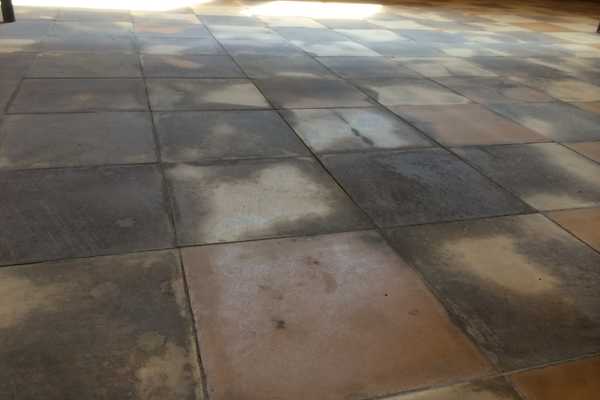
I feel ghoulish looking at them, more so taking photos. What is this, that the main attraction of a city is where ordinary people were tortured to death?
It’s hard to speak, as I don’t know what to say. Words fail me.
There’s little by way of maintenance here. Curling signage, and old materials. It’s like we’re forgetting Cambodia’s tragic history, as we missed it happening in real-time.

It’s a place where prisoners were given numbers.
And when there weren’t enough numbers they were shared. This more than anything makes me cry. To not even be a number seems so unimaginable.
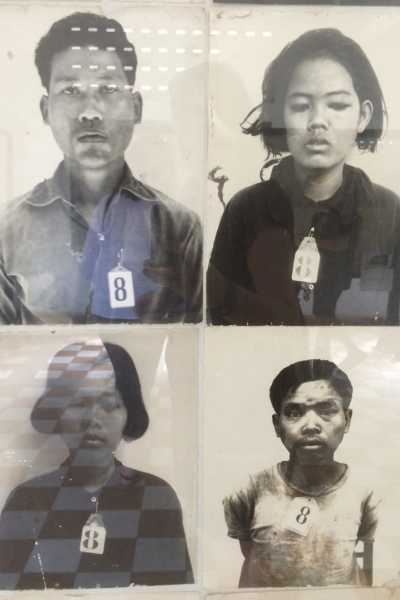
There were Westerners here too.
Australians, Americans, and a man, no more than a boy really, from Newcastle, England who just happened to be in the wrong place at the wrong time. John Dewhirst’s story is here:

How did I not know more about this? How did the world not know more of this? The borders were mainly closed. We didn’t have the Internet. TV wasn’t invasive in our lives.
And yet what has changed? How do I not know more about what is happening right now in Syria (when we were here in 2014), or Ukraine in 2023 for instance? History, it seems, doesn’t provide answers, just more questions and soul-searching.
You can combine visiting Tuol Sleng with a trip to the Choeung Ek Genocidal Center – this half-day tour also provides transport between the two sites as well as an English-speaking guide. You can check availability here.
How long to spend at Tuol Sleng in Phnom Penh
The first time we visited we spent about 60 minutes at Tuol Sleng. On our second visit in 2023, we spent nearly 2.5 hours here.
- Address of Tuol Sleng S-21 Prison: Phnom Penh, Khan Chamkar Mon, Cambodia
- Opening Hours of Tuol Sleng S-21 Prison: The S-21 Prison is open daily, from 8:00 am to 5:00 pm.
- Entry Fees for Tuol Sleng S-21 Prison: The s-21 prison entry fee is $5 without an audio guide and $8 with an audio guide. Pay for a personal guide at Tuol Sleng with a US$5 donation per person.
If you’re heading on to Siem Reap, then the War Museum there covers more of the history of the Khmer Rouge and the civil conflict here in Cambodia. You can read more about it here.
If you’re on a tour, then your guide will take you straight to Choeung Ek after visiting Tuol Sleng. If you’re traveling independently, then you may wish to take a break and have lunch before heading out.

If you travel independently, then I recommend using the PassApp to hail a tuk-tuk to go out to Choeung Ek. you can read more about transport in Cambodia, including the PassApp in my guide to Cambodian Transport here.
The Choeung Ek Genocidal Center, Phnom Penh
Here, this place that we’re at, is the Choeung Ek Genocidal Center. Just 15 kilometers (9.3 miles) from Cambodia’s capital, Phnom Penh. On our first trip here we took a tuk-tuk that waited for us until we finished, before dropping us back in the city. Some folks take a final tour of the Russian Market, one of the famous markets to visit in Phnom Penh , but I don’t think we’ll be able to stomach anything else after this.
We also traveled independently on our second trip.

This is a hugely emotional place to visit, if you prefer to go with a guide, then this option will also take you to the Tuol Sleng Genocide Museum at the S21 Prison in Phnom Penh.
Our tickets to enter cost us US$6 each. We pay in dollars because here in Cambodia there’s a dual currency. ATMs dispense dollars and Cambodian rials, you pay mainly in dollars but small change is given in Cambodian rials.
The US$6 entrance fee includes an audio guide. It is narrated by survivors. It is the reason why there is very little noise here. Listen to it. It is immensely moving. And harrowing. And it reminds me of the narrated audio guide at Hellfire Pass in Northern Thailand.
This is an incredibly uncomfortable visit. It’s not a place for selfies. For videos. Its a place for introspection and listening. And hopefully, learning too.
This place, Choeung Ek is an immensely emotional place to visit and you won’t feel comfortable visiting.
Thousands of men, women, and children died here.
No, that’s wrong, they were slaughtered here.
There was no easy slipping away. They were murdered. And their bones still lie here. You’ll sometimes see some of them working their way up through the soil. You’ll walk over them.
This is a hard place to visit. It was harder, if not impossible to survive it.
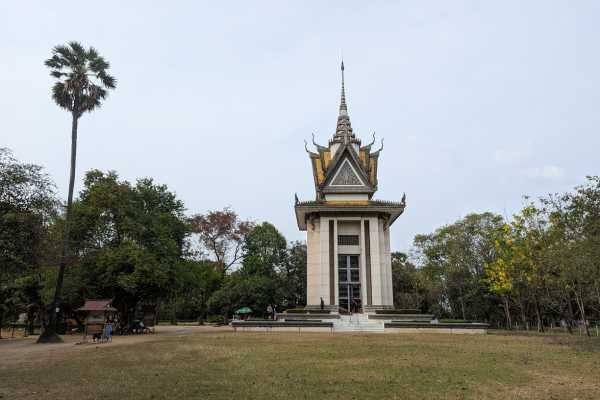
There’s one way to visit and that’s silently. There are no loud, noisy tour guides here, there are simple-to-use audio guides with headsets.
The narration is harrowing.
The first-person survivor accounts will stun you to silence.
Partly as a result of the headset and audio guides, this place is horrifically peaceful. Guided through the various areas by the audio tour, the birds sing and the wind sweeps through the trees
But the screaming in my head grows louder the further I walk into the site.
The stupa containing the bones and skulls of victims doesn’t seem real.

It’s the voices on the audio that make it real. The signage gives details of the locations as we walk slowly around.

This, below, is the Killing Tree, where to save bullets, small children, and babies were swung by their legs and cracked against the tree to kill them.
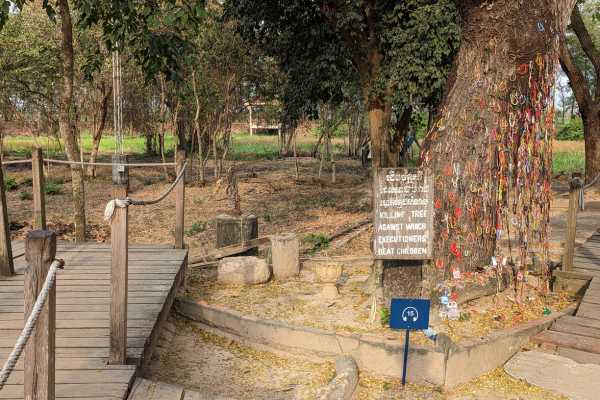
And why? What damage could a babe in arms do?
What was the Khmer mantra to justify this?
“To kill the grass, one must also dig up the roots”
Two million people died in Cambodia. During Pol Pot’s regime.
How can this be just a page in a history book?
How can my consciousness not have not known more about this? I feel myself searching for excuses as to why I didn’t know.
I find none, that silence, the screaming.
This is the sound of the wind, blowing through the trees as we walk around the lake. It seems fitting that this, the sound of silence is my rebounding memory of visiting.
And we leave Choeung Ek in silence – and take the tuk-tuk back towards Phnom Penh. It hasn’t changed since I was here 9 years ago. The silent screaming is still so loud it threatens to deafen me.
The Choeung Ek Genocidal Center is approximately 15 kilometers (9.3 miles) from the center of Phnom Penh. To get there, take Monireth Blvd south-west out of town from the Dang Kor Market bus terminal, you can take a Tuk Tuk there.
- Address of Choeung Ek Genocidal Center: Choeung Ek Street, Phnom Penh, Cambodia
- Opening Hours of Choeung Ek Genocidal Center: The Choeung Ek Killing Fields are open daily, from 8:00 am to 5:30 pm.
- Entry Fees for Choeung Ek Genocidal Center: The Choeung Ek Genocidal Centre entry fee is $6 per person, which includes headphones and a multilingual audio guide.
Travel Tips for Exploring Cambodia
- Considering travel insurance for your trip? World Nomads offers coverage for more than 150 adventure activities as well as emergency medical, lost luggage, trip cancellation, and more .
- Get online immediately with an eSIM for Cambodia
- Download and install a VPN BEFORE you travel to Cambodia > discount coupon here
- Arriving by air? Book your airport transfer with Welcome Pickups here.
- Book the best Cambodia tours and guides on Get Your Guide
- Save money in Cambodia with a Wise debit card
- Read about getting around Cambodia in our guide to Cambodian Transport
- Book Buses in Cambodia with 12goAsia
- Book accommodation in Cambodia with Booking
Final Words on Visiting the Killing Fields Phnom Penh
Visiting the Choeung Ek and Tuol Sleng in Phnom Penh are harrowing experiences that seem all the more pertinent to remember in today’s world. If you only know a little of the history here, as we did when we first visited, then the audio guides and local guides will explain more. These are difficult places to visit, but important to understand Cambodia.
We receive a fee when you get a quote from World Nomads using our affiliate links. We do not represent World Nomads. This is not a recommendation to buy travel insurance.
ASocialNomad is a participant in the Amazon Services LLC Associates Program, an affiliate advertising program designed to provide a means for sites to earn advertising fees by advertising and linking to amazon.com, amazon.co.uk, and amazon.ca. Amazon and the Amazon logo are trademarks of Amazon.com, Inc. or its affiliates. As an Amazon Associate, I earn from qualifying purchases .
Sarah Carter
Leave a comment cancel reply.
Your email address will not be published. Required fields are marked *
Save my name, email, and website in this browser for the next time I comment.
7 thoughts on “ How to Visit The Killing Fields Phnom Penh’s Dark History ”
- 7 comments
Great entry, Sarah. I too didn’t know of the killing fields until I saw “The Year of Living Dangerously” and I asked myself the same question- but it is easy Sarah. In the West we live our lives, distracted by the normal routine of the day, and that’s the way it should be. To always be aware and thinking about the evil things taking place in the world we couldn’t function. It would contribute to the evil-doer’s victory.
How many nights do you suggest for PP? We are only interested in the sights you took in also.
We had 2 nights there – arrived mid afternoon on the first day, and got our bearings, spent the next day seeing everything we wanted to, stayed that night and left the following morning.
Thanks. I really appreciate the feedback. Although it is a must stop, I am reading that the safety conditions there for petty theft, dishonesty, etc have deteriorated over the last few years, so we are only planning on spending minimal time in PP. So one full day you can see the Killing Fields and Prison adequately you think? We are trying to fit Cambodia and Laos in two weeks, so every day counts.
We very much enjoyed (if you can call dark tourism enjoyable? but I’m sure you know what I mean..) our time in PP, but it was short. We picked up motorised tuktuks from outside our hotel, and booked them for the KIlling Fields and then from there onto the Prison. Went first to the KF, and did the full audio tour and a lttle bit longer there, then lunch, although we werent particular hungry, and then to the prison and back to hotel. We were back at hotel by say 330pm. It’s an emotionally draining experience, we normally take longer than most visitors around places, and generally go very slow at places like this, so yes both in the same day will be fine. It will be the transport between all your places in Cambodia and Laos that kills the time, the roads arent great, and while it might feel like your transport is going fast… its just the roads!
Thank you so much for this information.
Hi Sarah, I stumbled upon your page by pushing wrong keys. However I took a read into one of the countries you visited. (Cambodia) I worked with a Cambodian woman in Australia of which we became very good friend On my leaving the job we planned to meet in 15 years time 2033 for a vacation to both our countries. Cambodia and New Zealand. Im glad I visited this page I learnt lots about Cambodia I never knew thanks
Privacy Overview
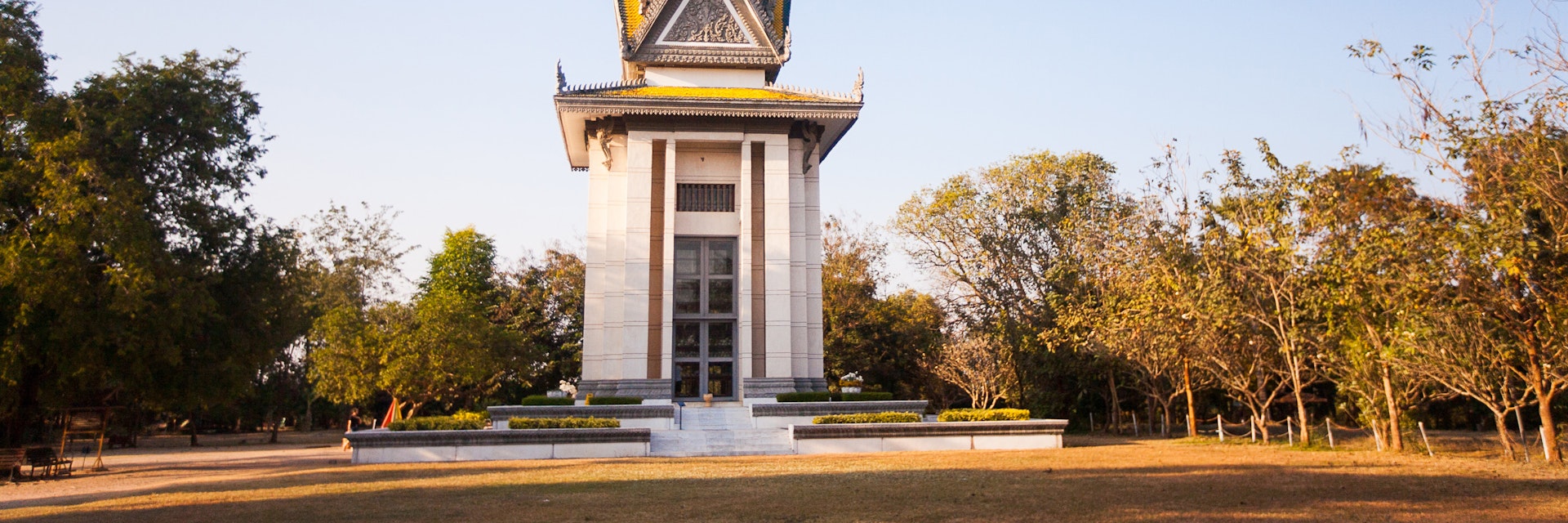
© telnyawka/Getty Images/iStockphoto
Killing Fields of Choeung Ek
Top choice in Phnom Penh
Between 1975 and 1978, about 20,000 men, women, children and infants who had been detained and tortured at S-21 prison were transported to the extermination camp of Choeung Ek. It is a peaceful place today, where visitors can learn of the horrors that unfolded here decades ago. Admission includes an excellent audio tour, available in several languages.
The remains of 8985 people, many of whom were bound and blindfolded, were exhumed in 1980 from mass graves in this one-time longan orchard; 43 of the 129 communal graves here have been left untouched. Fragments of human bone and bits of cloth are scattered around the disinterred pits. More than 8000 skulls, arranged by sex and age, are visible behind the clear glass panels of the Memorial Stupa , which was erected in 1988.
The audio tour includes stories by those who survived the Khmer Rouge, plus a chilling account by Him Huy, a Choeung Ek guard and executioner, about some of the techniques they used to kill innocent and defenceless prisoners, including women and children. There's also a museum here with some interesting information on the Khmer Rouge leadership and the ongoing trial. A memorial ceremony is held annually at Choeung Ek on 20 May.
The site is well signposted in English about 7.5km south of the city limits. Figure on about US$10 for a remork-moto (drivers may ask for more) for a half-day. A shuttle-bus tour is available with Phnom Penh Hop On Hop Off , which includes hotel pickup from 8am in the morning or 1.30pm in the afternoon.
Suggest an edit to this attraction
Lonely Planet's must-see attractions
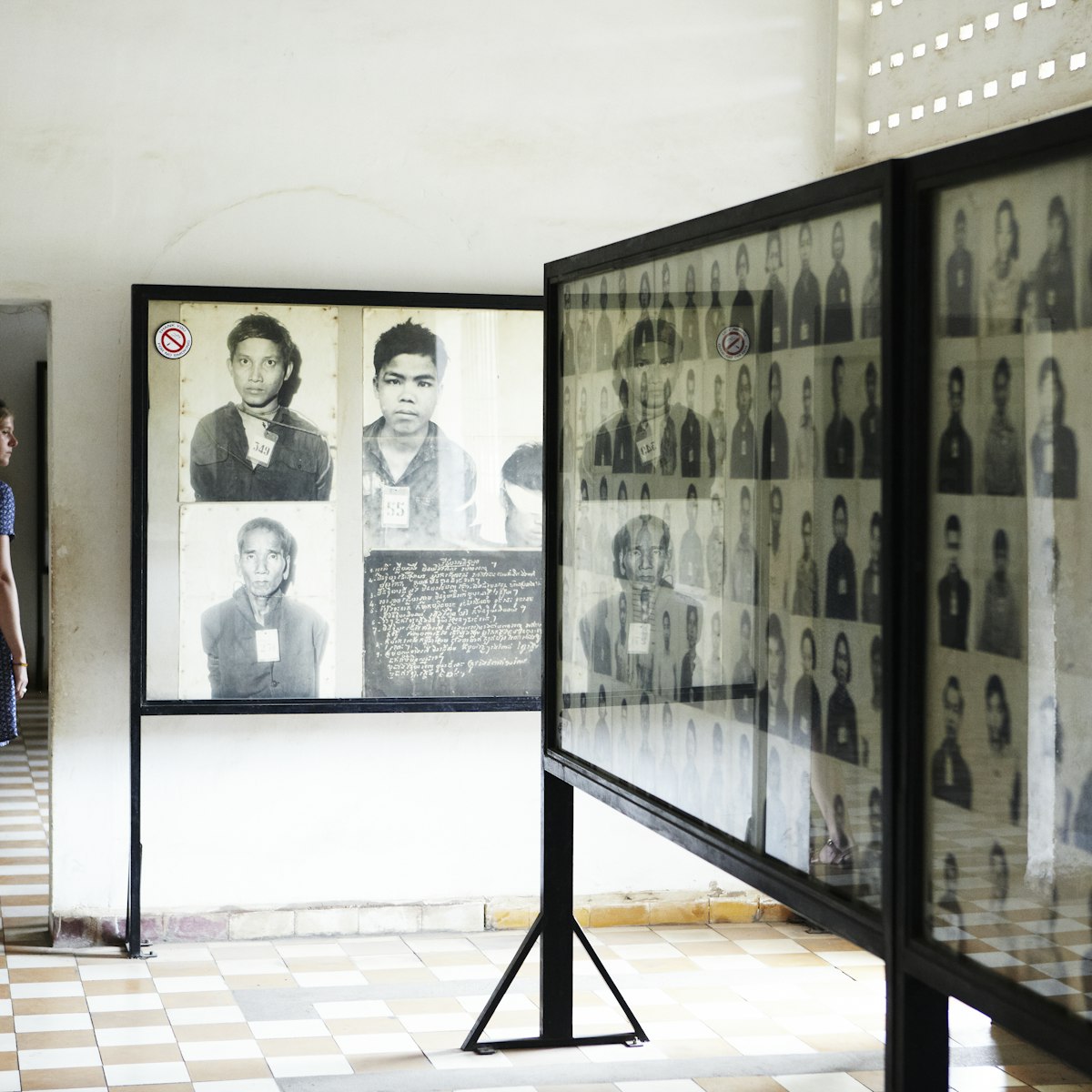
Tuol Sleng Genocide Museum
In 1975 Tuol Svay Prey High School was taken over by Pol Pot’s security forces and turned into a prison known as Security Prison 21 (S-21); it soon became…
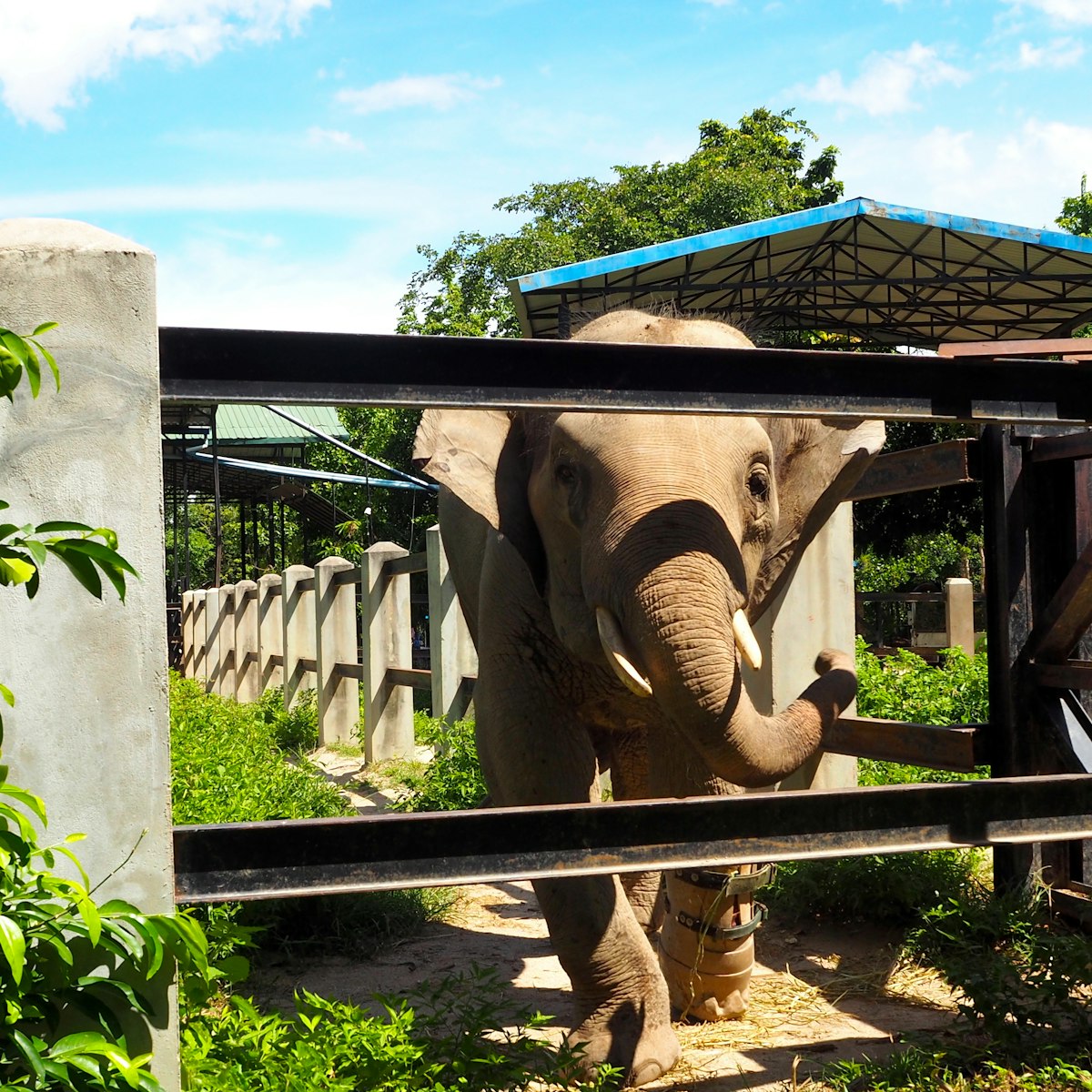
Phnom Tamao Wildlife Rescue Centre
14.37 MILES
This wonderful wildlife sanctuary for rescued animals is home to gibbons, sun bears, elephants, tigers, lions, deer, enormous pythons and a massive bird…
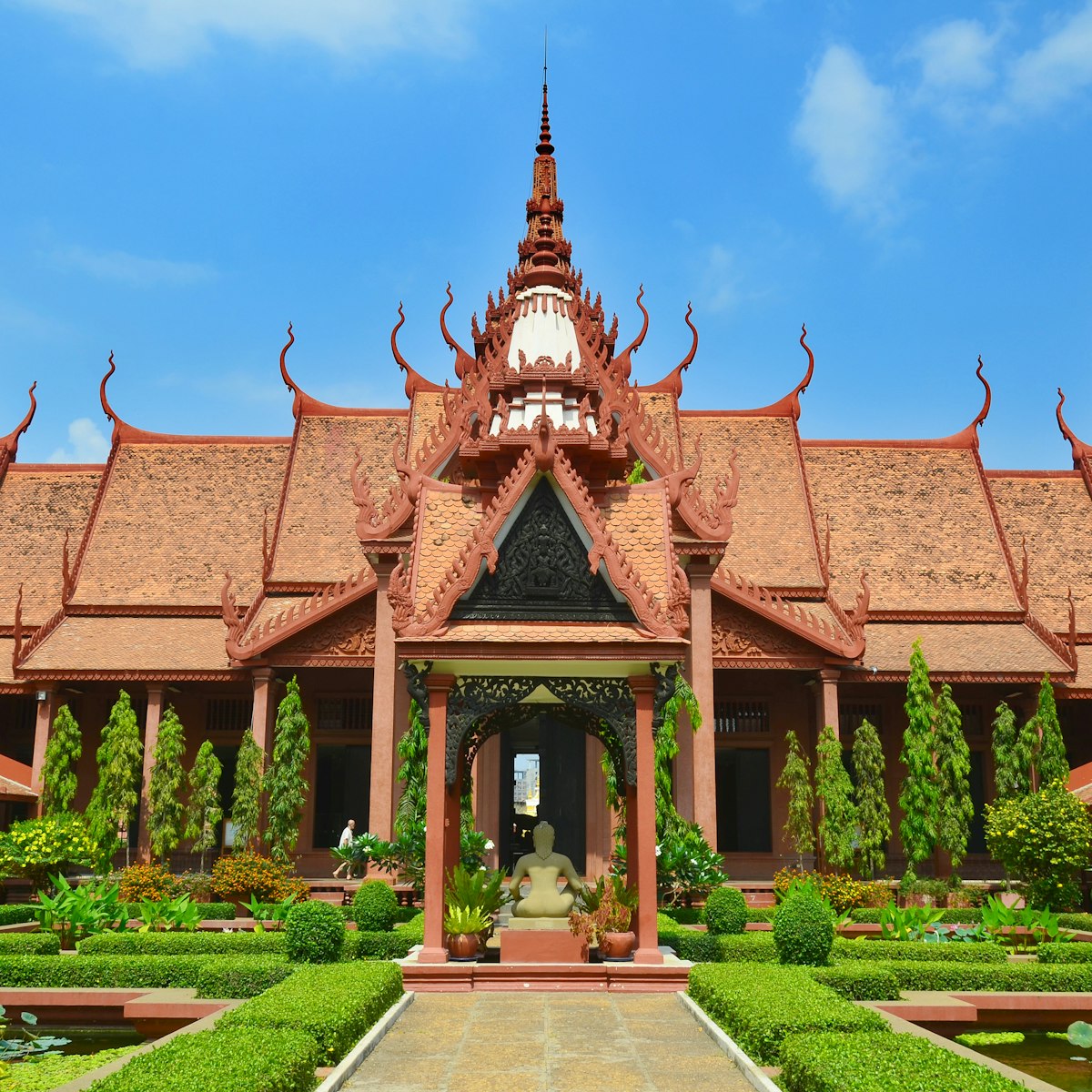
National Museum of Cambodia
The National Museum of Cambodia is home to the world’s finest collection of Khmer sculpture: a millennium’s worth and more of masterful Khmer design…
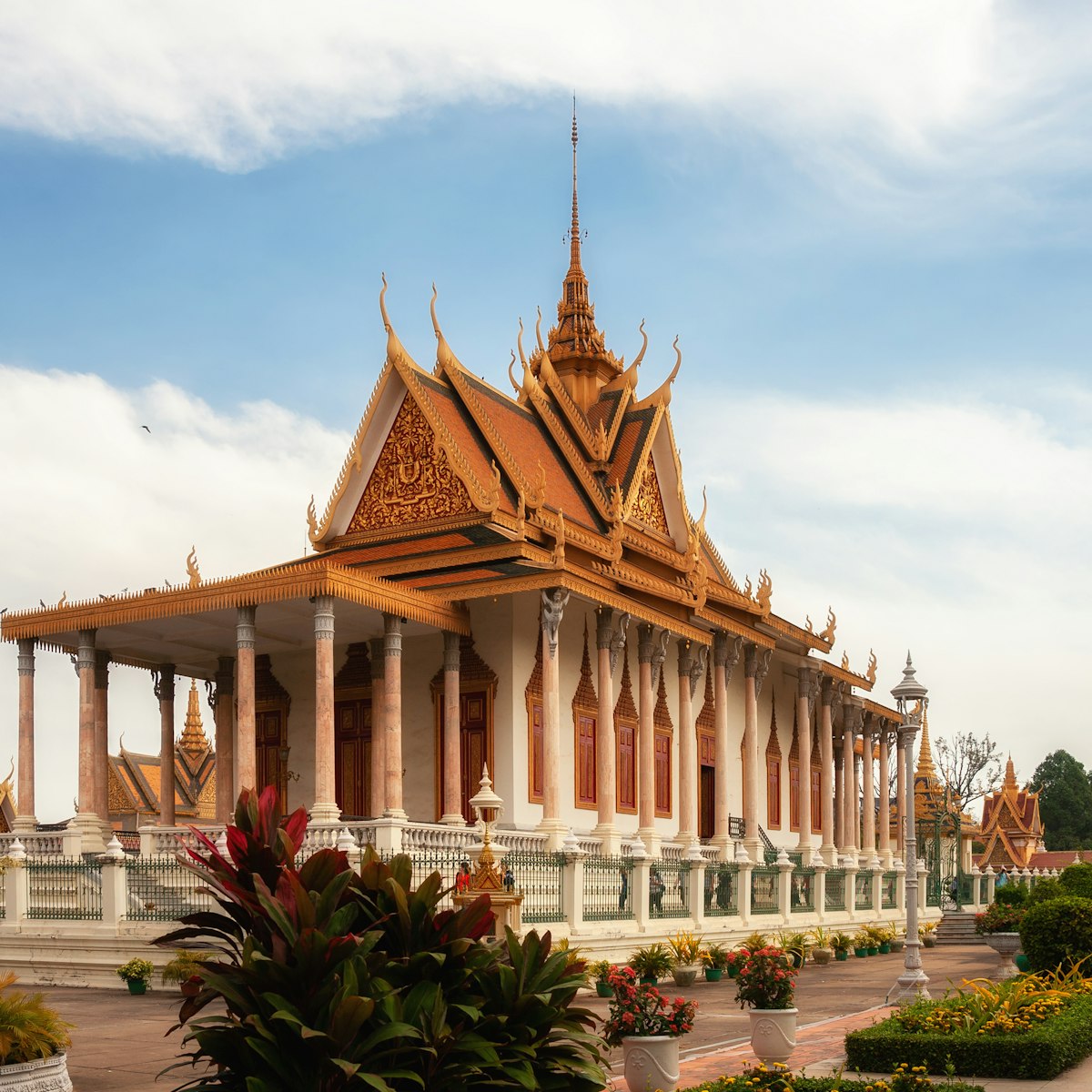
Silver Pagoda
Within the Royal Palace compound is this extravagant temple, also known as Wat Preah Keo or Temple of the Emerald Buddha. The Silver Pagoda is so named…
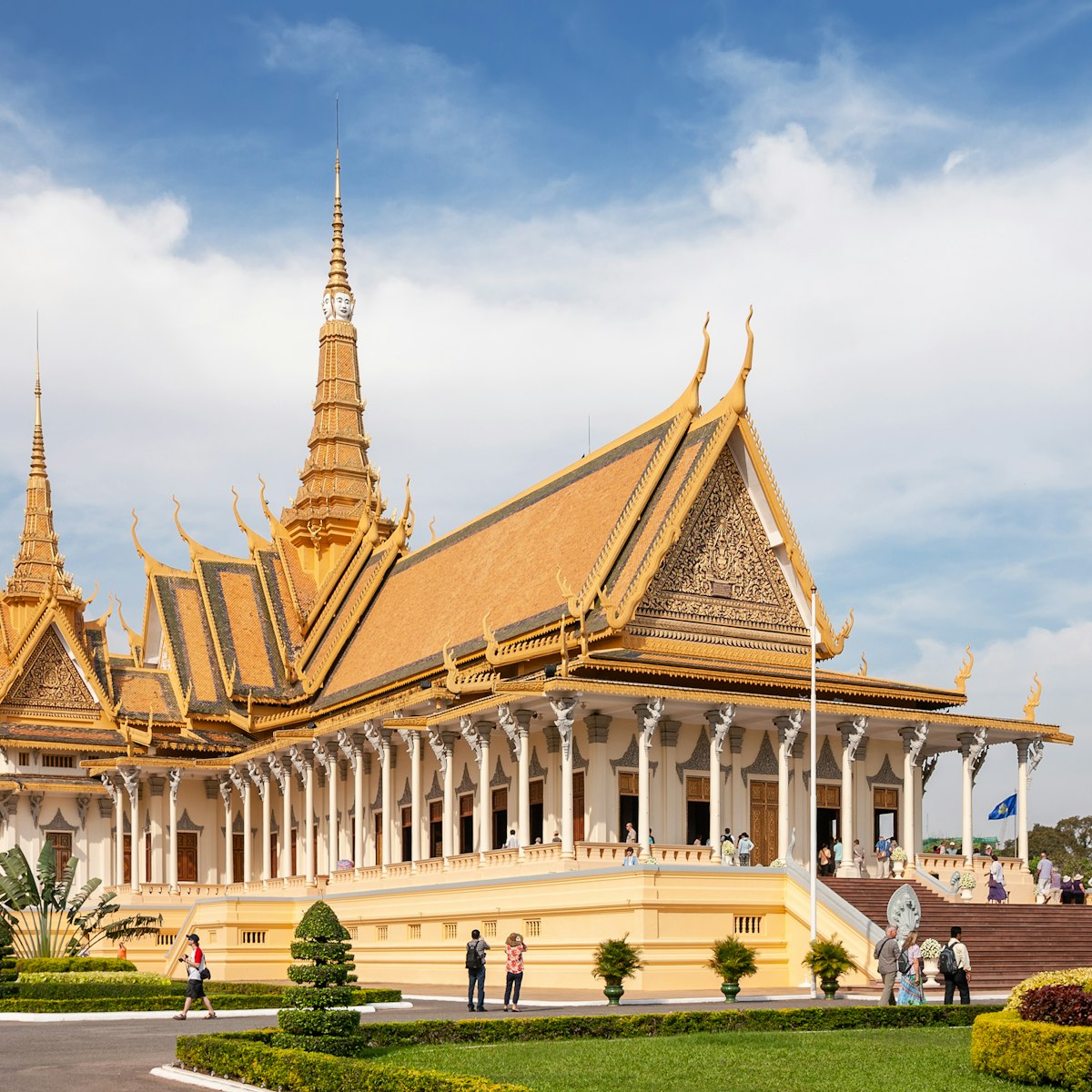
Royal Palace
With its classic Khmer roofs and ornate gilding, the Royal Palace once dominated the skyline of Phnom Penh. It's a striking structure near the riverfront,…
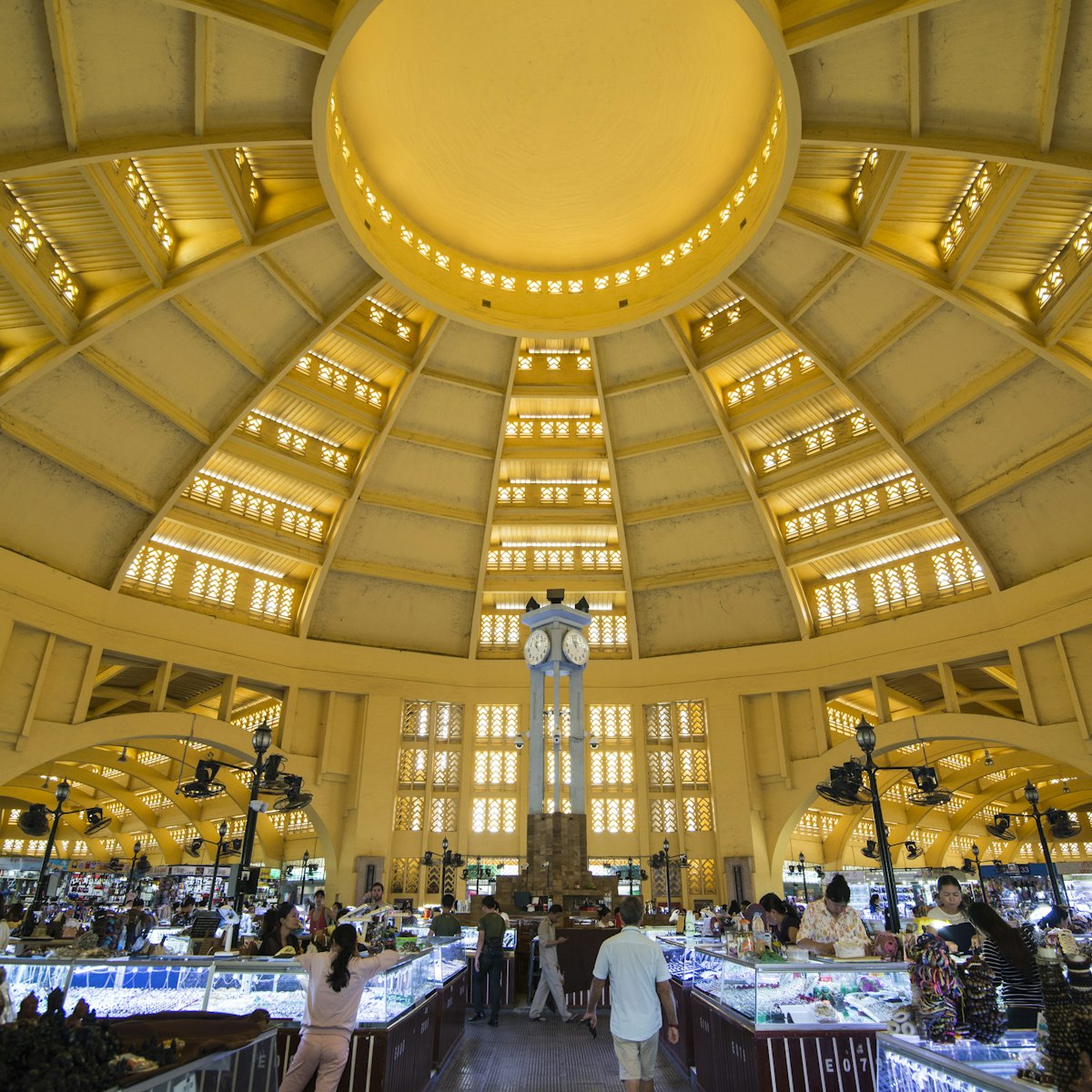
A landmark building in the capital, the art deco Psar Thmei (literally 'New Market') is often called the Central Market, a reference to its location and…

Cambodia finally got a sizable contemporary arts space in 2019, when Kbach moved into three galleries covering 400 sq metres of Factory Phnom Penh. The…

Factory Phnom Penh
This 3.4-hectare Levi's garment factory, 2km south of town, was completely transformed in 2018 into a graffiti-covered hub for entrepreneurs, artists and…
Nearby Phnom Penh attractions
1 . Kbach Arts
2 . Factory Phnom Penh
3 . Tuol Sleng Genocide Museum
4 . Wat Moha Montrei
Wat Moha Montrei was named in honour of one of King Monivong’s ministers, Chakrue Ponn, who initiated the founding of the pagoda (moha montrei means ‘the…
5 . Olympic Stadium
Despite the lofty name, this multipurpose sports complex has never hosted an Olympic Games. Nevertheless, it's a striking example of 1960s 'New Khmer'…
6 . Wat Langka
A colourful Buddhist temple in the heart of the city (near Independence Monument) that was established as a sanctuary for holy writings.
7 . Independence Monument
Modelled on the central tower of Angkor Wat, Independence Monument was built in 1958 to commemorate the country’s independence from France in 1953. It…
8 . Norodom Sihanouk Statue
This impressive statue shows the legendary former king/prime minister/statesman King Father Norodom Sihanouk, who died a national hero in 2012.

- dark tourism
- Andaman & Nicobar
- Bosnia & Herzegovina
- Channel Islands
- Cyprus (North)
- Czech Republic
- Dominican Republic
- Easter Island
- El Salvador
- Falkland Islands
- French Guiana
- Great Britain
- [Nagorno-Karabakh]
- Netherlands
- New Zealand
- Northern Ireland
- North Korea
- Philippines
- South Africa
- South Georgia
- South Korea
- Switzerland
- Transnistria
- Tristan da Cunha
- Turkmenistan
Choeung Ek killing fields

> More background info
> What there is to see
> Location
> Access and costs
> Time required
> Combinations with other dark destinations
> Combinations with non-dark destinations
> Photos

- disclaimer & privacy policy
© dark-tourism.com, Peter Hohenhaus 2009-2024
- Tourism Watch
The Killing Fields of Cambodia

Genocide on the Tourist Itinerary
In neighbouring Vietnam it was war that killed millions, but here it was sheer madness. A quarter of the whole population of Cambodia in the 1970s lost their life in the criminally insane attempt of the Khmer Rouge to make the country a genuine communist state. It all happened in just three years, between 1975 and 1978, until the Khmer Rouge regime was overthrown by the Vietnamese military in January 1979. Today, some of the sites where the most gruesome atrocities were committed have become memorial sites to educate visitors of a painful, not so distant past clad in blood and tears.
When the Americans withdrew from Vietnam in April 1975, Cambodia came under the total control of the Communist Party, nicknamed by the French as Khmer Rouge, the ‘Red Khmer’. The world was soon to witness one of the most horrifying genocides in the history of mankind.
The Khmer Rouge wanted to take the country back to its supposedly glorious past in which the rice growing ancient Khmer society built Angkor. To create a genuine peasant society, no one was spared. Private property, markets, schools, and religion were abolished. Cooperatives were formed throughout the country where people were forced to work, eat and live together. They had to dress in the way peasants dressed. Working hours were doubled from eight to sixteen. Cambodia became a gigantic prison farm. Even the slightest expression of dissent invited death. Killing fields and concentration camps grew in numbers to suppress any form of possible opposition.
Tuol Sleng Genocide Museum
No testimony of the atrocities committed by the Khmer Rouge can be as authentic as the haunting expressions in the photos of prisoners exhibited at Tuol Sleng. It was the Khmer Rouge’s premier security institution, designed for the interrogation and extermination of ‘counter revolutionaries’. Any suspects – men, women and children – were brought from every part of the country and imprisoned in Tuol Sleng. Almost all of the more than 15,000 inmates were brutally executed. Today, Tuol Sleng is a genocide museum and on the itinerary of many tourists visiting Phnom Penh.
Thousands of photographs of prisoners are mounted on the prison walls still stained with blood. Before prisoners were put into the cells, they were photographed. At every stage of torture they were photographed. And a few minutes before their execution they were again photographed. Four decades later, their expressions ask us: Why am I here? Why did this happen? Why have we been killed? Their faces indict the Red Khmers’ leader Pol Pot, his paranoia and the deeds of his regime. As we observe the victims, they observe us. While we focus our camera on their frozen expressions they seem to ask us, “Why are we being photographed again?”
The Killing Field of Choeung Ek
Equally haunting is the display of thousands of human skulls stored in a stupa at the killing field in Choeung Ek. It is here that prisoners from Tuol Sleng were executed. Each skull behind the glass seems to be staring at the visitors. Their expressions are in extreme contrast to the mysterious smiles on the faces of colossal figurines of Angkor built by their ancestors centuries back. They represent all victims of all genocides that happened anywhere in this world at any juncture.
The landmine legacy
Forty six million landmines were laid across the country by Khmer Rouge in their two decade long futile attempt to come back after being overthrown by Vietnamese army in 1979 – three landmines each for every surviving Cambodian. It is estimated that 64,000 people lost their lives in landmine explosions in Cambodia since 1979. Over 40,000 survived as amputees. Beggars approaching tourists in Phnom Penh or Siem Riep include only a few visible victims. In 21 districts located in the north west of Cambodia, landmines still remain a serious threat. According to the Cambodian Mine Action Authority (CMAA), it would require 400 million US dollars in aid to clear all landmines and UXOs (unexploded ordnances) in the country by 2025.
“I survived in Cambodia”
Light coloured T-shirts imprinted with the catchphrase “I survived in Cambodia”, sold by Cambodians and worn by tourists, may seem to just naively fit in with a series of “I survived…” souvenirs, along with “I survived my trip to Paris” or “I survived Oktoberfest”. In Cambodia, however, the slogan comes across as worse than just sarcastic. It grossly trivialises genocide and the fact that the atrocities committed in the 1970s have not ceased to affect people’s lives.
Local people are not usually keen to talk to travellers about the crimes committed by the Khmer Rouge. They tend to obliterate them from their collective memory. But to visitors in Cambodia, Tuol Sleng, the Killing Fields, and the land still contaminated by mines speak a lot. They speak of a history we have to learn from and reflect upon in order to prevent such horrible crimes against humanity from ever being repeated again – anywhere in the world.
Vinod Krishnan T.Y. works at the Centre for Research & Education for Social Transformation (CREST) in Calicut, India. As part of his research on ethnic minorities he has been working on the Cham minority of Cambodia and Vietnam.
Infoservice
The most important backgrounds every two to three months
Useful Resources
- Tourist Information Center
- CBET Destinations
- Advice for Travelers
- Where to Shop
- Public Holidays
- Currency Exchange
- Video & Tourism Spot
- Weather & Forecast
- Tourism Law
Phnom Penh (Capital City)

Choeung Ek Memorial (The Killing Fields)
Located about 17km south of Phnom Penh, Choeung Ek was once an orchard and a Chinese graveyard. It was used by the Khmer Rouge regime as an execution ground to put down thousands of people between 1975 and 1979. The site is now better known as the Killing Fields. Mass graves containing thousands of bodies were discovered at Choeung Ek after the fall of the Khmer Rouge regime. Many of the dead were former inmates in the Tuol Sleng prison.
Today, Choeung Ek is a memorial, marked by a Buddhist stupa. The stupa has acrylic glass sides and is filled with more than 5,000 human skulls; many of which are either shattered or had evidently been smashed. It is believed that the Khmer Rouge soldiers kill their victims by smashing them on the head, in order to save on bullets.
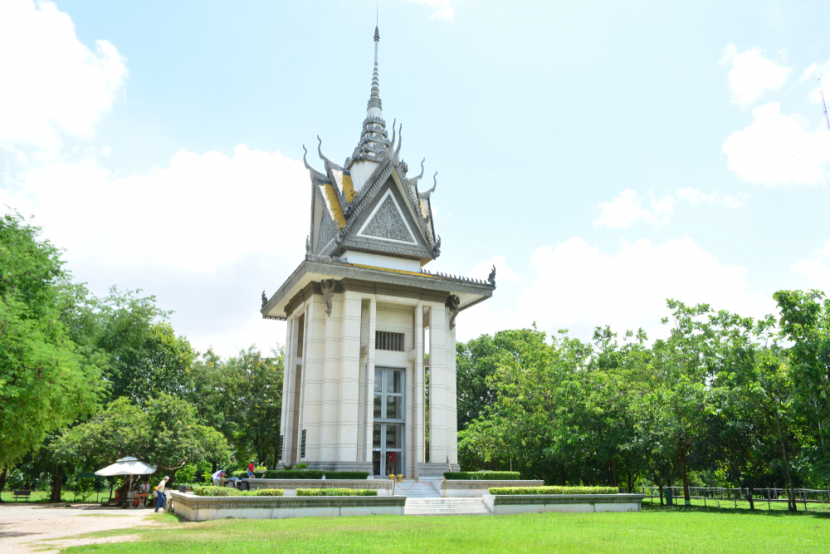
Wat Phnom (Wat Phnom Daun Penh)
The Wat Phnom temple is the most significant of all the temples in Phnom Penh. It is from here that the city of Phnom Penh was born.
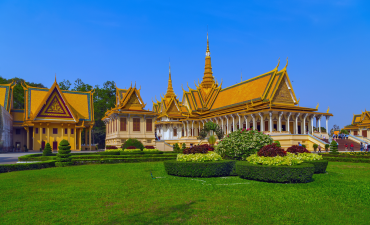
Royal Palace
The Royal Palace of Cambodia is a complex of buildings although it is generally understood to be the royal abode of the King of Cambodia.
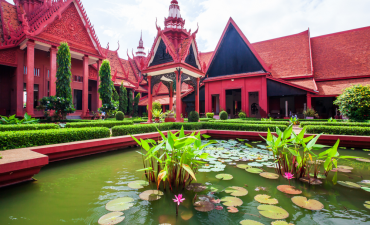
National Museum
The National Museum of Cambodia in Phnom Penh is the country’s leading historical and archaeological museum inaugurated by King Sisowat in 1920.
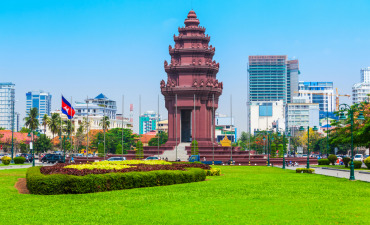
Independence Monument (Vimean Ekareach)
Located at the intersection of Norodom Boulevard and Sihanouk Boulevard in the heart of Phnom Penh city, the Independence Monument attracts many touri...
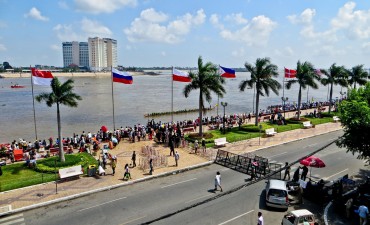
The park-like Riverfront is a great place to spend a day absorbing local flavours; watch the people unwind, enjoy the activities on the river and the...
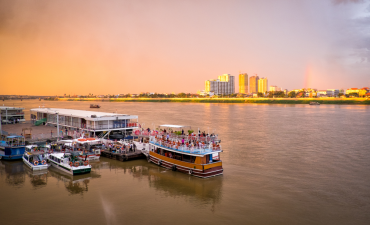
River Cruise
Rivers are the foundation of our society. The mighty Mekong River is indeed, in more ways than one, the lifeline that runs through the heart of south-...
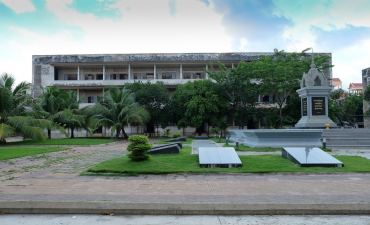
Toul Sleng Genocide Museum (S-21)
Prior to 1975, Toul Sleng was a high school. When the Khmer Rouge came to power it was converted into the
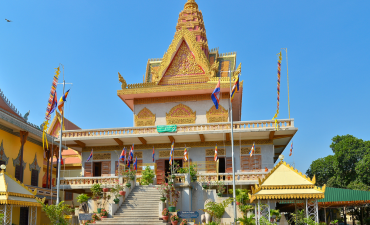
Ounalom Monastery
The origin of the Ounalom Pagoda can be traced to as far back as the 15th Century. It was built in 1422 by
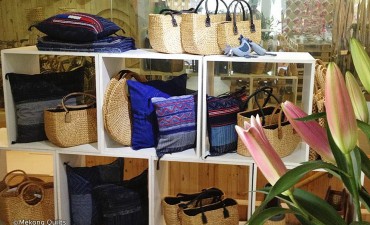
Street 240's tree shaded avenue harbors a unique collection of quality boutiques and souvenir shops,
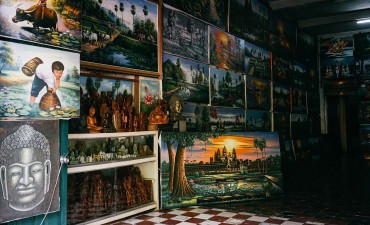
Street 178 has long been known as 'Art Street' for the local sculpture shops and art galleries that line the

Tuol Tompoung Market
The Toul Tum Poung market, also known as the Russian market, is Must Visit of Phnom Penh.
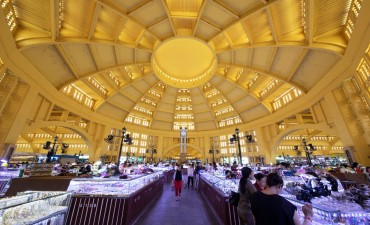
My lockdown fantasy: I wish I was back in the bustling, mind-blowing beauty of Phnom Penh
Hovering like a banana-coloured flying saucer above the dusty, congested streets of scooters and cyclo taxis, the central market of Phnom Penh is a re...
WIN WIN MEMORIAL
Built to commemorate the success of Prime Minister Hun Sen’s Win-Win policy that brought the return of solarity and peace to the nation, the Win-Win M...
NIGHT CRUISE
One of the more popular tour programs in Phnom Penh is a night cruise on the Mekong river, leisurely enjoying the stars in a romantic environment.
Norodom Sihanouk Memorial
The memorial is dedicated to the late king’s accomplishment in liberating Cambodia from France in November of 1953.
central market
Central Market, the Phsar Thmey built in 1937, is a stylish Art Décor rotunda with wings extending in four different directions.

Provincial Guides
Phnom Penh (Capital City) Rattanakiri Mondulkiri Siem Reap Preah Sihanouk Stung Treng Kratie Preah Vihear Kampot Kep Koh Kong Kampong Thom Kandal Takeo Battambang Kampong Cham Kampong Chhnang Kampong Speu Pursat Oddar Meanchey Pailin Prey Veng Svay Rieng Banteay Meanchey Tbong Khmum
This website, Tourismcambodia.org, the official website of Ministry of Cambodia of the Kingdom of Cambodia, is designed and maintained collaboratively by RED DOT (Cambodia) Co., Ltd and Cybernetics Ltd a full service branding and advertising agency in Cambodia. While efforts are made to ensure that all the information hereto are good, accurate and up to date, by visiting the website Tourismcambodia.org, viewing, accessing or otherwise using any of the services or information created, collected, compiled or submitted to Tourismcambodia.org, you agree to be bound by the our Terms and Conditions of Use, (Click here). If you do not want to be bound by our Terms, your only option is not to visit, view or otherwise use the services of Tourismcambodia.org. You understand, agree and acknowledge that these Terms constitute a legally binding agreement between you and Tourismcambodia.org and that your use of Tourismcambodia.org shall indicate your conclusive acceptance of this agreement.
© 2024 | DESIGNED & HOSTED BY: RED DOT (CAMBODIA) CO., LTD | All Rights Reserved. Disclaimer

The Killing Fields in Cambodia- 3 reasons NOT to visit
Disclaimer: Some posts on Tourism Teacher may contain affiliate links. If you appreciate this content, you can show your support by making a purchase through these links or by buying me a coffee . Thank you for your support!
Is it ethical to visit the Killing Fields in Cambodia? This is a question that many travellers will ask themselves. Whilst it is fascinating to learn about this horrible history, and education is always a good thing, is it right that we as tourists are taking photographs of the victim’s skulls and walking along the paths that once saw such extreme terror and devastation?
Ethics is always a subjective and somewhat grey area and it is a personal opinion as to whether you should or shouldn’t visit the Killing Fields in Cambodia. But if your mind isn’t made up yet, I have outlined the benefits and disadvantages in this informative article.
What are the Killing Fields in Cambodia?
The history behind the killing fields, the s-21 museum, projects in cambodia, reasons against visiting the killing fields in cambodia, ethical tourism: the killing fields of cambodia, further reading.

In the 1970s, Cambodia saw a civil war. This ended in 1975, and the country was then run by the Khmer Rouge. They were the Communist Party of Kampuchea. There are fields across Cambodia where over a million people were killed and buried; these are known as the Killing Fields of Cambodia. This was the Cambodian Genocide. Around 2.5 million people were killed in total by the Khmer Rouge and their policies – but approximately 1,386,734 were executed at these fields.
The name came from Dith Pran. He was a journalist, and survived the destructive Khmer Rouge regime. He saw people poisoned or beaten to death – children included. You can now visit the Killing Fields of Cambodia…. but is this ethical? Lets find out…
The Khmer Rouge regime was led by Pol Pot. He has since been described as a “genocidal tyrant” due to the sheer scale of the murders carried out by his party. They arrested and killed pretty much everyone who was suspected of being connected with either the former Cambodian government or with foreign governments. Among those executed were Vietnamese, Thai, Chinese and Cham a well as Cambodian Christians and Buddhist monks.
Political criminals were warned by the Khmer Rouge, twice, if they had done something the party deemed “wrong”. After that they were sent away for re-education which, generally, meant they would be executed. Often they were persuaded to confess to their ‘crimes’. These crimes were generally things like having contact with foreign sources or engaging in free-marketing activity.
The Khmer Rouge regime has been described as totalitarian, xenophobic, autocratic, repressive and paranoid. On top of the executions, they had various social engineering policies in place which led to so many deaths. They even had something called the Maha Lout Ploh. This was an imitation of something China did called the Great Leap Forward – an agricultural reform through collective farming which ultimately led to the Great Chinese Famine. Similar happened in Cambodia with the Khmer Rouge’s copycat games. The party also insisted on self-sufficiency which meant there was a lack of medicine in many cases. This only led to more deaths.
What can you see at the Killing Fields of Cambodia?
You can visit the Killing Fields of Cambodia. It is best to do so with a guide, so you can really understand what it is you are seeing. There are plenty of tours available, but I generally recommend Viator as they are reliable and have English speaking guides. You can see the tours that Viator are currently offering here . Audio guides are available too.

Information points make it easier to digest your surroundings, and there are various things to see at the Killing Fields in Phomn Penh. These include bone fragments and clothes as well as untouched communal graves – the resting places of hundreds of thousands of victims. There is also a Buddhist memorial stupa here, filled with skulls, which is the main focus of this site. It is important to show respect at the Killing Fields of Cambodia, by generally acting in the way that you would at a memorial: no selfies, no smoking, no eating or drinking.

You can also visit the S-21 Museum. Its full name is the Tuol Sleng Genocide Museum, and it chronicles the Cambodian genocide as well as the general actions of the Khmer Rouge. It is a former secondary school, used as a prison (Security Prison 21) during the regime. Around 20,000 people were imprisoned here between 1976 and 1979. It was also one of the many (around 196) torture and execution centres of the regime.
Did you know: the prison’s chief, Kang Kew Iew, was convicted in July 2010. He was convicted by the Extraordinary Chambers in the Court of Cambodia for crimes against humanity and multiple breaches of the 1949 Geneva Conventions. He was serving a life sentence. Iew died in 2020.

The museum site has 4 main buildings. These are known as A, B, C and D. Many rooms are entirely preserved, left just as they looked when the Khmer Rouge were driven out of power in 1979. Thanks to the records kept by the regime themselves, the museum has a wealth of photographs of prisoners and more. You can see cells, weapons, photo galleries and more at the S-21 Museum when visiting the Killing Fields of Cambodia.
S-21 Museum is open from 8am until 5pm. You can also view a survivor testimony from 2.30-3pm daily.

Reasons FOR visiting the Killing Fields of Cambodia
There are many reasons to visit the Killing Fields of Cambodia. Many call it ‘ dark tourism ’ and while it is (by definition) an example of this, it is also somewhere that is so important in terms of education. There is a reason why the ECCC (Extraordinary Chambers in the Court of Cambodia) arrange for Cambodians themselves to visit on study tours!
As with many places like the Killing Fields of Cambodia (such as Auschwitz, for example) it is worth remembering the famous George Santayana quote. “Those who cannot remember the past are condemned to repeat it”. This is so true – and the Khmer Rouge regime was less than 50 years ago. It is well within living memory. Remembering what happened and educating future generations is important to potentially prevent things like this from happening again.

Educational tourism is a brilliant way to provide a hands-on, up-close learning experience. By visiting the Killing Fields of Cambodia, locals and tourists alike are able to gain further insight into the cultural, social and historical impacts of the Cambodian genocide. This is true of many ‘dark tourism’ destinations. Providing real-life context for the things we can read about in books is a brilliant way of hammering home what happened under the control of the Khmer Rouge in Cambodia.
Visiting the area – and Cambodia itself – is a way of supporting the families who were torn apart by this genocide. Given that it really wasn’t so long ago, people are still rebuilding. By shopping locally and putting money into the Cambodian economy, you can support this beautiful country in recovering from its tragic past.
When visiting Cambodia to experience the history of the Killing Fields, it is worth looking into local charity projects. Many of these exist (and need to exist) because of the tragedy brought upon the country by the Khmer Rouge and the horrific Genocide.
The Starfish Project , for example, provides support for local disabled people through its sales of delicious baked goodies. There are various organisations across Cambodia doing similar things for marginalised groups!
You can volunteer in Cambodia too, if long-term travel is something you are looking into. This is always a worthwhile way to spend your time while abroad. You are able to give back to local communities and ensure a brighter future for many local people and areas.

#1- Some people would disagree with the idea of visiting the Killing Fields of Cambodia because they are against the notion of ‘ dark tourism ’.
They say that it is a terrible form of voyeurism, and fetishises the collective trauma of countries and cultures. Does visiting the Killing Fields (or Alcatraz , or Hiroshima) simply render these places a spectacle? Or, as mentioned above, is it a way to remember what happened and educate people? People who disagree with dark tourism are, of course, likely to disagree with the idea of visiting the Cambodian Killing Fields.
#2 There are also personal reasons as to why people may not want to visit the Killing Fields.
It is, as you might expect, a heart-wrenching experience. There are many people alive today who were alive at the time of the Khmer Rouge regime. They may have memories of what happened during this period of history, or know people who were personally affected by the regime. It is an emotionally disturbing experience. Those with a weak disposition are probably best avoiding a visit to the Killing Fields of Cambodia.
#3 The types of tours and tourists are not always respectful.
The most important thing when visiting a site such as the Killing Fields in Cambodia is to show respect. However, there are many tour companies that are profit-focussed rather than people-focussed.
Whichever side you are on when it comes to the pros and cons of visiting the Killing Fields, it is important to do so ethically. Be respectful during your visit. As mentioned above, this means no selfies or eating/drinking. Dress appropriately too, and treat the area delicately. Remember that this is the site of one of the most horrific genocides in history. It may not be one that gets talked about as often as other genocides, but it is still a regime that killed over 2 million people for no reason. Respect the memory of the people who died here, and their living relatives.
If you found this article interesting, you may also like to read-
- Top 10 dark tourism destinations (including WUHAN!)
- Dark tourism explained: What, why and where
- Ethical tourism: Everything you need to know
- Are zoos ethical? The pros and cons of visiting the zoo
Liked this article? Click to share!

Visit Koh Ker - The UNESCO World Heritage List
VIEW DETAILS
Book Tour to Angkor Wat
- Cambodia News & Media
- Cambodia Travel News
Killing Fields tourism
- Cambodia Events & Sports
- Business & Trade Fairs
- World Travel News
News & Media

21 Sep 2011 2086 | Cambodia Travel News
IT WAS only 7.30 in the morning but the heat oozing from the tarmac left me in no doubt that I had escaped an unusually cold Australian winter and landed firmly in the tropics. Moments before, I had been gazing in awe out the plane window at the landscape of endless rice paddies as our plane descended over Cambodia's capital. Threading its way through the patchwork of ponds and paddocks and palm trees was the mighty Mekong River. This massive brown artery connects Cambodia with Laos and China to the north and Vietnam to the south-east, where it drains into the South China Sea through the vast Mekong Delta. The bustling city of Phnom Penh is on the convergence of the Tonle Sap, Mekong and Bassac rivers. These days, most visitors include the charming city on their travel itinerary because of the genocide tourism that has developed out of the horrors that were committed by the Khmer Rouge between 1975 and 1979. The other reason people come to Cambodia is for the temples, which are mostly to the north-west around the town of Siem Reap. Built in the Angkor period between the ninth and 13th centuries, they are the pride of the nation and a marvel of mankind. I quickly fell in love with Phnom Penh. The city is alive with activity and you could spend a week just sitting on a corner watching life go by and not tire of the spectacle. It's a city of opportunity in a country still trying to find its way after the murder of almost two million people by the Pol Pot regime. Exclusive hotels and restaurants accommodating the growing tourist trade sit awkwardly among the relative squalor of local life. The legacies of the Vietnam War saw up to two million refugees choke the small capital before it was taken over by the Khmer Rouge. Despite falling to Vietnamese forces in 1979, the Khmer Rouge maintained a guerrilla war throughout the '80s and it wasn't until 1998 that the organisation was finally erased from the history books. Put this in context with tourism in 2011 and it is easy to understand why Cambodia can seem a little perplexing to the outsider looking in. Our first tourist destination was the Royal Palace and Silver Pagoda, which is the official residence of the king. These sparkling buildings seem a tad overdone for today's monarchy, but if you want to look at lots of gold, silver and diamonds, then this is the place to go. Nearby is the National Museum, which is worth checking out for a history lesson before heading to the temples. It contains original statues and artefacts rescued from temple areas. The palace and museum are near the French-inspired riverfront known as Sisowath Quay. It was here that we concluded our first day with a sunset river cruise, fine waterfront dining complete with a traditional dance show and a stroll through the quasi-carnival atmosphere along the esplanade. The Toul Sleng Genocide Museum was a school that became the S21-Prison. An estimated 17,000 people were tortured here before being trucked off to the Killing Fields. Visitors can tour the classrooms where inmates were chained to beds and walk the playground that was converted to a torture arena. The tragedy truly hit home for me when I reached the thousands of mug shots of innocent men, women and children who perished at the hands of the Khmer Rouge. The looks in the eyes of the helpless souls is enough to break anyone's heart. A painting of human babies being tossed in the air and shot like clay targets is imbedded in my mind. I would like to imagine the crude depiction was a figment of a sick imagination, but sadly it depicts a time in Cambodia not too long ago when the most unimaginable of horrors were a daily reality. From Toul Sleng, we travelled the same road that the truckloads of prisoners would have travelled to the Killing Fields of Choeng Ek, 17km from Phnom Penh and situated along a quiet dirt road amid farmland. You'd easily miss the morbid tourist attraction if it wasn't for the towering Buddhist stupa. The monument, containing more than 8000 skulls arranged by sex and age, is a significant tribute to the dead, yet I couldn't help but feel uneasy as we gazed into the opened cabinets with skulls inches from our faces. This uneasiness intensified as we walked through the fields of mass graves that are no more than open pits overgrown with weeds. Scraps of clothing and even shards of bones could be seen around the edges of the pits, making it hard to know where to walk. I'm not easily upset, but I couldn't wait to leave the killing fields and even now recalling the visit has my eyes welling with emotion. It's a strange way to spend a holiday but I'm glad to have experienced Cambodia's genocide tourism. The world needs to know what went on here, for even today the perpetrators of these horrors are still being brought to justice. Cambodia is much more than its grizzly past but all those who visit the beautiful country should take the time to respect what has taken place here.
Source - warwickdailynews.com.au
- ← Older
- Newer →
Sponsored News
More cambodia travel news.
- Jeeps a hit at Siem Reap temples
- Siem Reap prepares for Sankranta Festival
- 17 flights welcomed at new Siem Reap airport on first day
- Koh Ker Temple Listed as a World Heritage Site
- Restoration Team Shows Commitment to Restoring Ancient...
- Siem Reap Expects 7 Million Tourists 2023-2026
- Hun Manet sworn in as Cambodia’s new Prime Minister
- New Siem Reap Angkor International Airport (SAI) open for...
Recommended Cambodia Tours

Cambodia Day Tours

Angkor Temple Tours

Cambodia Classic Tours

Promotion Tours

Adventure Tours

Cycling Tours
Trip planner.
- Essential Information
- General Infomation
- Food & Drink
- Events in cambodia
- Travel Maps
- Accommodations
- Flight Details
- Transportation
- Tour Packages
- Travel Guides
Useful Links
- Cambodia Visa
- Useful Contacts
- Tourist Information
- Phnom Penh Postal Code
- Advertise with us
Travel Services
- Cambodia Tours
- Cambodia Flights
- Cambodia Hotels
- Boat/Cruise Ticket
Travel News & Media
- Cambodia Events
- Download & Media
- Photo Gallery
Agency offering information about Cambodia on tourism, culture, history, visa, attractions, province guides, trip planner, hotels, flights, cars, tours, news, photo and online bookings.
- Copyright © 1999-2024 Tourism of Cambodia. |
- Privacy Policy |
- Terms of Service |

IMAGES
VIDEO
COMMENTS
In Cambodia, nine miles (14.5 kilometers) from Phnom Penh, the "killing fields" of Choeung Ek have become a tourist attraction, horrifying and fascinating. Choeung Ek is one of thousands of other ...
Depending on traffic, it's a 45-60 minute journey away from the city centre. It's possible to visit the site by private taxi or tuk-tuk, as part of a Phnom Penh Killing Fields tour, and even with the public bus network. Here are the key costs + details to help you plan for each: 1.
Welcome to the Phnom Penh Killing Fields, a somber and historically significant site located just outside the capital city of Cambodia. This haunting place serves as a reminder of the country's dark past and has become an important destination for those seeking to understand the atrocities committed during the Khmer Rouge regime from 1975 to ...
He's talking about the Killing Fields at Choeung Ek and the Tuol Sleng Genocide Museum. They are major tourist sites in Phnom Penh, and commemorate the atrocities perpetrated by Pol Pot and the Khmer Rouge on Cambodia in the 1970s. During that time, millions of Cambodians around the country were forced to evacuate Phnom Penh and other cities ...
The importance of visiting Cambodia's Killing Fields. written by Bex Shapiro March 14, 2017. Visit Phnom Penh today and, at first glance, the scars of genocide are far from visible. Cambodia's capital is the country's most populous city - busy, vibrant, cultured. Yet just decades ago it was a ghost town.
Marissa 26 March 2024. During the Khmer Rouge reign, from 1975 to 1979, an estimated 1.7m to 2.5m Cambodians died from execution, starvation or disease - almost a quarter of the population. Killing fields dot the country, with more than 20,000 mass grave sites containing more than 1.38m bodies, according to the Documentation Centre of Cambodia.
Killing Fields of Cheung Ek is situated 15 kilometers south-west of Phnom Penh and made famous by the film of the same name "Killing Field". it was a place where more than 17,000 civilians were killed and buried in mass graves; many of them transported here after detention and torture in Toul Sleng. This place is a chilling reminder of the ...
The largest of the Cambodia Killing Fields was at Choeung Ek just outside Phnom Penh. This is our guide to visiting the specific sites of Phnom Penh's Killing Fields, if you're looking for the best things to do in Cambodia's capital city, Phnom Penh, then our guide is here. We visited both Tuol Sleng and Choeung Ek in both 2014 and 2023.
CHOEUNG EK GENOCIDAL CENTRE (OR THE KILLING FIELDS CAMBODIA) WHAT TO EXPECT CHOEUNG EK GENOCIDAL CENTRE. Located in a non-descript farming district on the outskirts of Phnom Penh lies the former extermination camp of Choeung Ek.It was here that between 1975 and 1978 around 17,000 men, women, children and infants who had been detained and tortured at Tuol Sleng were transported to be murdered.
The Killing Fields ( Khmer: វាលពិឃាត, Khmer pronunciation: [ʋiəl pikʰiət]) are a number of sites in Cambodia where collectively more than 1,000,000 people were killed and buried by the Communist Party of Kampuchea during Khmer Rouge rule of the country from 1975 to 1979, immediately after the end of the Cambodian Civil War ...
Killing Fields of Choeung Ek. Top choice in Phnom Penh. Between 1975 and 1978, about 20,000 men, women, children and infants who had been detained and tortured at S-21 prison were transported to the extermination camp of Choeung Ek. It is a peaceful place today, where visitors can learn of the horrors that unfolded here decades ago.
This is THE national memorial site for the Cambodian Genocide at the hands of the Khmer Rouge under Pol Pot between 1975 and 1979. It's best known by the name "The Killing Fields" (even though it was just one of many such fields) - and has become a premier tourist attraction in Cambodia.In fact it is one of the top dark tourism destinations world-wide (see lists - esp. Top 20 overall, and ...
It is estimated that 64,000 people lost their lives in landmine explosions in Cambodia since 1979. Over 40,000 survived as amputees. Beggars approaching tourists in Phnom Penh or Siem Riep include only a few visible victims. In 21 districts located in the north west of Cambodia, landmines still remain a serious threat.
CAMBODIA'S KILLING FIELDS. Between 1975 and 1979, two to three million people were killed in Cambodia by the extreme communist guerilla group the Khmer Rouge. This was genocide in its purest, most evil form. Since the end of the 1960s the Khmer Rouge had been forming guerilla armies in the jungles that lined Cambodia's border with Vietnam.
Watch: Tourism at Cambodia's Genocide Sites Raise Concern. Embed share. ... The bones at Choeung Ek and the remnants of S-21, like all the other Killing Fields sites, are evidence and crime sites ...
Choeung Ek is the best known of the genocide sites. It is also known as the Killing Fields. The site is located 17 kilometers south of Cambodia's capital city, Phnom Penh. Each day, tourists ...
CAMBODIA'S KILLING FIELDS. Between 1975 and 1979, two to three million people were killed in Cambodia by the extreme communist guerilla group the Khmer Rouge. This was genocide in its purest, most evil form. Since the end of the 1960s the Khmer Rouge had been forming guerilla armies in the jungles that lined Cambodia's border with Vietnam.
Delve into the history of the Killing Fields, first stopping to explore the haunting Toul Sleng Genocide Museum with a guide who will regale you with stories of Pol Pot, the Khmer Rouge, and the harrowing loss of lives in this area. Next, enter Choeung Ek Genocidal Center to learn more about Cambodia's history from 1975 to 1979.
It was used by the Khmer Rouge regime as an execution ground to put down thousands of people between 1975 and 1979. The site is now better known as the Killing Fields. Mass graves containing thousands of bodies were discovered at Choeung Ek after the fall of the Khmer Rouge regime. Many of the dead were former inmates in the Tuol Sleng prison.
Some people are not comfortable visiting the Killing Fields in Cambodia. #1- Some people would disagree with the idea of visiting the Killing Fields of Cambodia because they are against the notion of ' dark tourism '. They say that it is a terrible form of voyeurism, and fetishises the collective trauma of countries and cultures.
The site at Choeung Ek is actually just one of many "killing fields" throughout the country. In total, Pol Pot and his Khmer Rouge soldiers killed around 1.7 million Cambodians. While the Nazis built gas chambers for mass slaughter, the Khmer Rouge killed people in the cheapest way possible. To save money on bullets, they just bludgeoned or ...
The Killing Fields of Choeung Ek are 15 km from Central Phnom Penh. To get there, take Monireth Blvd south-westward out of the city from the Dang Kor Market bus depot. ... Agency offering information about Cambodia on tourism, culture, history, visa, attractions, province guides, trip planner, hotels, flights, cars, tours, news, photo and ...
An estimated 17,000 people were tortured here before being trucked off to the Killing Fields. ... Agency offering information about Cambodia on tourism, culture, history, visa, attractions, province guides, trip planner, hotels, flights, cars, tours, news, photo and online bookings.